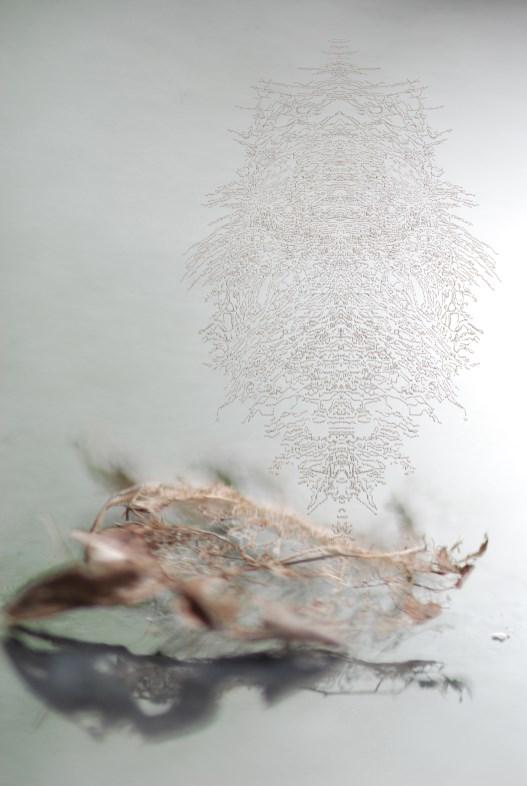VISION: AN ARTIST’S PERSPECTIVE
Presented by Gutfreund Cornett Art and UniteWomen.org at Kaleid Gallery, San Jose, California
July 5 - July 29, 2016
3
4

5 6 INTRODUCTION Gutfreund Cornett Art 11 ABOUT UniteWomen.org 12 NOTES from Unitewomen.org 13 ABOUT Kaleid Gallery 14 ABOUT the Special Recognition Jurors 15 Suzanne Gray STATEMENT 16 Michelle Nye STATEMENT 17 Kaleid Gallery ARTISTS 95 Slideshow ARTISTS
Envision, conceive of, imagine . . . In this turbulent time of political changes, women's rights, social, racial, gender and economic inequality, global conflicts, cultural instability, reproductive choice/health care issues, and environmental challenges of overconsumption and resource scarcity - how do we effect positive change through art? How do we listen, speak our minds, include, and act in collaboration or alone across generational differences, races, identities and cultures, to build our future, locally and globally?
With VISION, Gutfreund Cornett Art and UniteWomen.org brought self-identified women artists into dialogue, retracing an account of the past manifesting in the present, to address major social themes, to define and bring forth what is important to themselves, their families, their communities, our nation and the world at large with art that reflects complex sociocultural issues and focuses on a vision for a more positive, empowering future.
We asked self-identified women artists to respond to and take an active role in this conversation to create an exhibition in all mediums and genres. The art ranged from literal to poetic, abstract to representational, and psychological, to social and political commentary and represented the prismatic, collective vision for our future to inspire communities and provide a framework for true innovation in our time.
The call for art for Vision: An Artist’s Perspective went out to “self-identified women artists”. This term acknowledges that gender identification is not limited to biology. By sharing our perspectives and experiences, divisiveness can grow into solidarity, understanding and strength amidst all of the myth and muddiness of social policies, press and statements from misogynist organizations. As a whole, this show is underpinned by the feminist principle that believes in political, economic and social equality for all. For this exhibition self-identified female artists from across the U.S. and Canada, representing multiple generations, races and cultural viewpoints, submitted strong and compelling works on the many issues affecting women today.
Violence, the “War on Women” and Reproductive Rights: Amy Pleasant, Voices in Her Head #, retells her story of survival of sexual assault as a child. The young girl’s frank, open gaze foreshadows the destruction of her world as her power and innocence is taken away from her as well as her bike. Sara Cole, Forgotten Woman 2, addresses global violence against women and the resulting loss of femininity through a resolute but faceless and hairless woman with red drips running seemingly as tears or blood. SPOOKY BOOBS COLLECTIVE, You Stupid Cunt, uses controversial verbiage—commonly used to diminish and minimize women to “keep them in their place”. The brash words are in sharp contrast as they are weaved into the beautifully designed Victorian-like wallpaper in which “cunt” is repeated over and over. Cheri Redlinger with the photograph Abortions Provided in Back Alleys, and Sarah Nguyen book-art, How Does Your Garden Grow, displaying drawings of plants used to assist in abortions, starkly address what women may need to return to if reproductive rights are rolled back in the current fight to control women’s choice and health. Beth Fein, Speak Truth to Power, gives voice in twenty-four languages to the need for us to speak up against aggression and wrong doing and to honor those who have confronted repression and injustice.
Identity and Gender Roles:
Suppositions of identity and gender roles play an integral part in this exhibition with work ranging from conceptual to explosive. Alabaster, by Katherine Collins, shows a veiled, wrapped face which overlays concepts of identity and personality in what we choose to conceal or reveal. With Now You Can Touch My Hair, Nastassja Swift highlights her experience as a black
6 INTRODUCTION: Gutfreund Cornett Art
experience as a black woman artist exploring feelings of doubt and anxiety and the coping mechanisms to better understanding identity. Lynn Dau’s sculpture Disorder, an erupting sink, addresses gender roles and how women's work is considered undervalued, and reminiscent of collective anger women may feel at having to do yet one more load of dishes. With woven, cast aluminum, Victoria Helena Mihatovic ponders the dichotomy of gender roles and choices in regards to maternity and the weight it puts on the female in the sculpture Maternity Wear. The installation, Plumb Boobs by Sondra Schwetman, weaving across the floor, takes us on the path to understanding feminine identity perspectives and the feminist journey. In Tara Booth’s moving video In(gest) a woman is poked, prodded and pinched mercilessly, while the other frame shows the same character ingesting fruits and vegetables until it appears she may vomit. In her statement she wonders, “how much is forced and how much is self-inflicted,” exemplifying the gender roles to which woman are expected to subscribe.
Aging, Illness, Beauty and Sexuality:
Addressing the mind and the body, feminist artists reject the social norm that beauty and worth are only assigned to the young and that “women of a certain age” lose their power and fade away. The gaze is direct and filled with melancholy in Marky Kauffmann’s Lost Beauty: Burns Facial Wrap. Her work addresses the concepts of beauty and aging with implications that women are compelled to reverse the effects of aging to remain forever young so as not to disappear. Yolanda Guerra, with No Strings Attached, celebrates female sexuality with no constraints and rejects any imposed notions against pleasure through social norms, religion or guilt. Through a classical styled drawing, Janice Whiting, in Three Ages of Women, addresses the contradictory message that in order to be desirable, women must be both the virgin and the whore but also young, refuting the idea that a women’s sexuality and beauty vanishes with the passing years, as we all must age. With layered textures and imagery in Is It Mine?, Caren Helene Rudman reflects on the disconnect between mind and body while enduring illness and the subsequent powerlessness that ensues, but still persisting to hold onto hope to give strength and power to overcome obstacles.
Empowerment and the Human Condition:
With Cleanse and Exfoliate, Emily Dvorin creates a whimsical but intricately structured textural, sculptural basket using repurposed, re-contextualized materials that speak to environmental concerns of our tendency of over-consumption of commercial goods and societal excess. Resigned but with trepidation, Rickety Lawn Chair and Happy Gardens by Beth Lakamp reflects on the disproportionate insecurity women face in retirement. Surreal and dreamlike, Intuition of Home by Cynthia Tom tells lucid stories envisioning a future world with more empowerment for women. In American Woman, Blonde Jenny creates an alternative universe for her character to represent an American women having equality in society and the freedom to become whatever she wishes. In a precarious situation of uncertainty – is she sinking or is she rising? J Howard’s Drowning in Emotions represents self-awareness and victory over adversity and conflict. With Try to See, Remedios Rapoport encourages and supports self-awareness and creating positive change and global interconnection.
Why do we think “women-only” shows are still relevant and important? Art representation and exposure for women artists is changing, but much still needs to be done. There has been more focus on women artists and feminist art history since Linda Nochlin asked "Why have there been no great women artists?" in 1971, but the number of women represented in the current edition of Janson’s “History of Art” has risen from none, in the 1980s, to only twenty-seven today. Maura Reilly referenced the famous Guerilla Girls 1986 Report Card and Pussy Galore’s 2015 update showing the still disturbing lack of gallery representation for women artists, despite some inroads, in her ARTNews article Taking the Measure of Sexism: Facts, Figures and Fixes. “The more closely one examines art-world statistics, the more glaringly obvious it becomes that, despite decades of postcolonial, feminist, anti-racist, and queer activism and theorizing, the majority continues to be defined as white, Euro-American, heterosexual, privileged, and, above all, male.” (Reilly)
7
Begun as an informal statistical research project to create dialogue about underrepresentation and undervaluing of women’s art, Micol Hebron’s 2013 (En)Gendered (In)Equity: The Gallery Tally Poster Project, became the unique and quickly growing socially-engaged art project Gallery Tally. Through crowdsourcing, this project has brought together over 2000 artists from around the world to collect and organize data from the top contemporary art galleries. Recent estimates show an average representation of thirty percent female artists to male artists’ seventy percent. “There is still a real problem with who’s getting opportunities, who’s getting shown, who’s getting collected, who’s getting promoted, and who’s getting written about,” Hebron says. (Reilly)
All female shows increase the opportunity for promotion and display of the work of established women artists and help us discover emerging ones. Jonathan Jones, art critic for the Guardian, wrote, in his review of the all women exhibition Champagne Life at the Saatchi Gallery, “The real reason women need to be represented properly in the art world is so the world can be fully represented in art.” (Jones) This is in sharp contrast to the statement by the late, but hugely popular, Guardian art critic Brian Sewell, “There has never been a first-rank woman artist. Only men are capable of aesthetic greatness.” (Gunter) Much work still needs to be done to break free from the common vernacular surrounding and defining women’s art.
Hilarie M. Sheets, in her New York Times article Female Artists Are (Finally) Getting Their Turn, highlighted the works of and renewed attention toward “artist forerunners”. She applauded the recent and upcoming women-only group shows, including Hauser Wirth & Schimmel’s Revolution in the Making: Abstract Sculpture by Women and Denver Art Museum’s Women of Abstract Expressionism. Within the last ten years, we have seen the Rubell Family Collection, No Man’s Land, in Miami, which showcased over 100 women artists, WACK: Art and the Feminist Revolution at MoCA in Los Angeles (2007) and Elles at the Pompidou Center (2009).
As the former National Exhibitions Director (Karen Gutfreund) and International Caucus Director (Sherri Cornett) for the Women’s Caucus for Art, we created multiple exhibition opportunities for women artists, some highlights which are: Who’s Afraid of Feminism? at A.I.R. Gallery (2015), Half the Sky: Intersections in Social Practice Art at Luxun Academy of Fine Arts/Shenyang, China (2014), Identity at gallery nine5 (2014), Equilibrium, Art for A Changing World at Woman Made Gallery (2014), Stories We Tell at the Phoenix Gallery/NYC (2013), Honoring Women’s Rights at the National Steinbeck Museum (2013), Women + Body in Seoul & Gwangju, South Korea (2012), and Man as Object: Reversing the Gaze, which showed at the Kinsey Institute Gallery (2012) and at SOMArts/SF (2011) and CONTROL at SOMArts/SF and Ceres Gallery/ NYC (2009). In reference to all women exhibitions, “They are curatorial correctives,” said Maura Reilly, the founding curator of the Sackler Center for Feminist Art at the Brooklyn Museum and now interim director of the National Academy Museum, who advocates for these exhibitions “to counterpoint the looked-overness.” (Sheets)
We see major museums, their boards and their donors working toward rectifying this lack. According to Museum Director Lisa Phillips, Artemis, a new program by The New Museum in New York, works towards “funding exhibitions and new commissions by female artists” and “represents a new generation of donors who are more activist patrons”. MoMA now has the Women’s Project (MWP), which focuses on research in the museum’s collection and the Modern Women’s Fund, which also funds major solo exhibitions, acquisitions and educational and public programs by and about women artists. Women are becoming museum directors and are moving into board leadership. And this, according to Jill Medvedow, Director of the Institute of Contemporary Art (ICA), Boston, changes the statistics. ICA board member Barbara Lee has gifted the museum with work by women artists from her collection and, through her foundation, funds exhibitions for women artists. (Harris, Halperin, Pees)
8
So what can be done to further promote equal representation in the art world? Linda Nochlin, urges women to “be fearless, speak up, work together, and consistently make trouble.” Reilly in her ARTnews piece added, “Let’s not just talk about feminism—let’s live it. Don’t wait for change to come—be proactive. Let’s call out institutions, critics, curators, collectors, and gallerists for sexist practices.” (Reilly).
We encourage artists and art patrons to practice and put into effect her additional suggestions:
Create feminist and women’s art shows
Organize conferences, launch feminist magazines and blogs
Establish and participate in feminist coalitions, collectives and direct-action groups fighting discrimination against women
Offer women’s and feminist art courses and teach from a feminist perspective
Hold collectors and museum boards accountable
We would add that we should look at the gray areas, the overlapping, nuanced and complex and changing definitions and experiences of female identity. Kimberlé Crenshaw, the executive director of the African American Policy Forum and a professor of law at Columbia University and the University of California, Los Angeles law schools originally coined the term “intersectionality” about how race and gender could intersect as forms of oppression. Its use has broadened to help us look at a larger variety and layered social situations, backgrounds and identities and how we can encourage, support, learn from, listen to, advocate for each other and the whole spectrum of female identity. (Crenshaw).
We are very pleased to have collaborated with UniteWomen.org and its President Karen Teegarden for this thoughtprovoking exhibition and opportunity for self-identified women artists, Vision: An Artist’s Perspective.
Works for this exhibition were selected from an impressive collection of submissions, by Sherri Cornett, Karen Gutfreund, Renee Phillips and Karen Teegarden. Suzanne Gray of Seager Gray Gallery and Michelle Nye of SFMoMA Artists Gallery then each selected three pieces, which they considered impactful and representative of the theme.
In order to accommodate as many viewpoints as possible and expand the conversation beyond the physical limitations of the museum, works were selected both for installation in the gallery and a looped slideshow shown in the gallery. Thank you to all of the artists who added their vision to this exhibition: Diyar Al Jazzi, Salma Arastu, Lynn Arnold, Joanne Beaule Ruggles, Tara Booth, Andrea Borsuk, Nellien Brewer, Andrea Broyles, Carolyn Cohen, Sara Cole, Katherine Collins, Lynn Dau, Emily Dvorin, Beth Fein, Linda King Ferguson, Anitra Frazier, Sara Friedlander, Sara Gallo, Lindsay Garcia, Caryl Gaubatz ,Linda Gleitz, Tricia Grame, Yolanda Guerra, J Howard, Georgie Humphries, Uma Rani Iyli, Olivia Jane, Blond Jenny, Kathryn Jill Johnson, Jennifer Jones, Thuy Linh Kang, Joanna L. Kao, Marky Kauffmann, Kristin Kempa, Sameh Khalatbari, J. L. King, Epiphany Knedler, Susan Kraft, Eileen Kressel, Biljana Kroll, Beth Lakamp, Mido Lee, Rebecca Levine, Krista Machovina, Stela Mandel, Kathryn McDonnell, Juliet Mevi, Victoria Helena Mihatovic, Beverly Mills, Jennifer Mondfrans, Shabnam Mottaghi, Sarah Nguyen, Min Kim Park, Jelisa Peterson, Sara Petitt, Amy Pleasant, Michele Poindexter, Lorena Pugh, Remedios Rapoport, Cherie Redlinger, Trix Rosen, Caren Helene Rudman, Gerri Russell, Sondra Schwetman, Pallavi Sharma, Marlene Siff, SPOOKY BOOBS COLLECTIVE, Sean Sterzer, Elka Stevens, Nastassja Swift, Kim Tepe, Cynthia Tom, Diana Tremaine, Natalie Waldburger, Ruth Waters, Corinne Whitaker, Janice Whiting, Jennifer Weigel with Laurel Luckey and Tina Ybarra.
We would like to thank the UniteWomen.org, Kaleid Gallery, Suzanne Gray, Michelle Nye, and our participating artists for their parts in broadening the conversation about issues affecting women.
9
Art can be a powerful, productive force instrumental in sparking change or critical thinking. Gutfreund Cornett Art is committed to supporting local, national, and global art activism to help us to understand what is happening in our society, who we are, where we come from and where we’re going. We specialize in creating exhibition opportunities for artists to stimulate dialog, raise consciousness and create social change.
 Karen Gutfreund and Sherri Cornett
Karen Gutfreund and Sherri Cornett
Works Cited: Crenshaw, Kimberle. “Mapping the Margins: Intersectionality, Identity Politics, and Violence against Women of Color”, Stanford Law Review, (July 1991): pp. 241-1299.
Gunter, Joel. “Brian Sewell’s best cutting critiques – in quotes” The Guardian. Guardian News and Media, 19 Sept. 2015. Web. June 2016.
Harris, Gareth, Julia Halperin and Javier Pes, “What does a female artist have to do to get a major solo show” The Art Newspaper. The Art Newspaper, 29 April 2016. Web. June 2016.
Jones, Jonatha. “Saatchi Gallery's all-female exhibition could start to shift male gaze of the art world” The Guardian. Guardian News and Media, 6 January 2016. Web. June 2016
Reilly, Maura. “Taking the Measure of Sexism: Facts, Figures and Fixes” ARTnews. ARTnews Associates, 26 May 2015. Web. June 2016.
Sheets, Hilarie M. “Female Artists Are (Finally) Getting Their Turn” New York Times, The New York Times Company, 29 March 2016. Web. June 2016.
10
UniteWomen.org was founded on social media, by one click of a mouse used to start a Facebook group. We have rapidly grown from that instantaneous start into having more than 120,000 followers and thousands working in the trenches with us on a daily basis. Everyone in UniteWomen.org is a volunteer, from the President to the volunteers handing out flyers on the streets. The fact that we are an organization comprised of people so devoted to equality that they are willing to donate their time to forward the cause brings us great pride, and it fuels our passion to work hard and accomplish our goals.
Ten weeks into our birth, we achieved our initial goal of organizing and implementing 55 rallies in 45 states across the country – all held on one day. Our group was then called, “Unite Against the War On Women.” We utilized all aspects of social media, and continue to do that every day on the national and local levels. Those rallies may have been our initial goal but we soon realized in order to really make a difference in women’s lives, we needed to create an organization, using social media platforms to spread information about protests, campaigns, legislation, calls to action and unification. Hence, UniteWomen.org was created.
On a daily basis, we manage over 250 different Facebook groups and hold meetings on Google Hangout with volunteers from across the country in real time. We also have a Campus Division, graphics, legislative, outreach, research and twitter departments, and twelve monthly task force campaigns for various human rights issues. Social Media enables us to work as a cohesive team from our own homes, and we have already accomplished so much that sometimes it’s overwhelming to think about it all!
Our groups have held vigils, protests, voter registration drives, volunteered at clinics and domestic violence shelters, held many coordinated social media events – including several Twitter bombs. We’ve met with legislators, joined with other groups for unification of human rights advocates, sponsored pro-choice events, co-sponsored the Suffrage Centennial Celebration in D.C., run campaigns such as Unite Against Rape and We Are Good Women. We have taken local initiatives started by others and brought them onto the national scale, such as Bethany Erickson’s Need Your Permission campaign. We have spoken at political and social conferences, protested conferences and statehouses. Most importantly, we have given a voice to tens of thousands of women in America who felt disenfranchised and wanted some way to take part in the now historic fight against the legislative War on Women.
UniteWomen.org is a national non-partisan 501(c)(3) tax-exempt nonprofit organization that works to end inequality for women that stems from prejudice and discrimination and works to advance the human and civil rights of women and girls. Donations to the organization are tax-deductible to the fullest extent of the law. UniteWomen.org Action is a registered 501(c)(4) nonprofit advocacy and lobbying organization for the cause. Contributions to UniteWomen.org Action are not tax deductible. If you would like to get involved with UniteWomen.org or make a donation, please visit our website at www.unitewomen.org

11 About UNITEWOMEN.ORG
Michelle Nye Juror Statement
It was a distinct pleasure to review the artworks submitted for Vision: An Artist’s Perspective, as there were many compelling entries. The three artworks chosen were well executed and thought provoking, capturing the imagination with humor, beauty and depth. Each work spoke on many levels and could inspire pages of reflection and inquiry. Below are just a few reasons why these three pieces strongly resonated with me.
For Cleanse and Exfoliate the quirky vessel’s organic and biological form contrasts with its woven artificial materials, deftly speaking to a range of issues surrounding women’s bodies, beauty ideals, environmental pollution, consumerism and the history of women’s craft and art. In Disorder everyday kitchen objects dramatically explode. The result is captivating, eliciting a powerful mix of associates including the rejection of traditional roles of women, the trauma of domestic violence, and the terrorizing impact of war and suicide bombers when they strike so close to home. With You Stupid Cunt we are seduced and affronted in equal measure. The alluring Victorian styled wall paper evokes traditional female roles of home-maker and sex object, especially when looking closely at the vulva shaped pattern. Juxtaposed is the incessantly repeated and ornately scripted word ‘cunt,’ inviting contemplation on issues such as the insidious aggression towards women and the pervasive objectification and domination of women’s bodies.
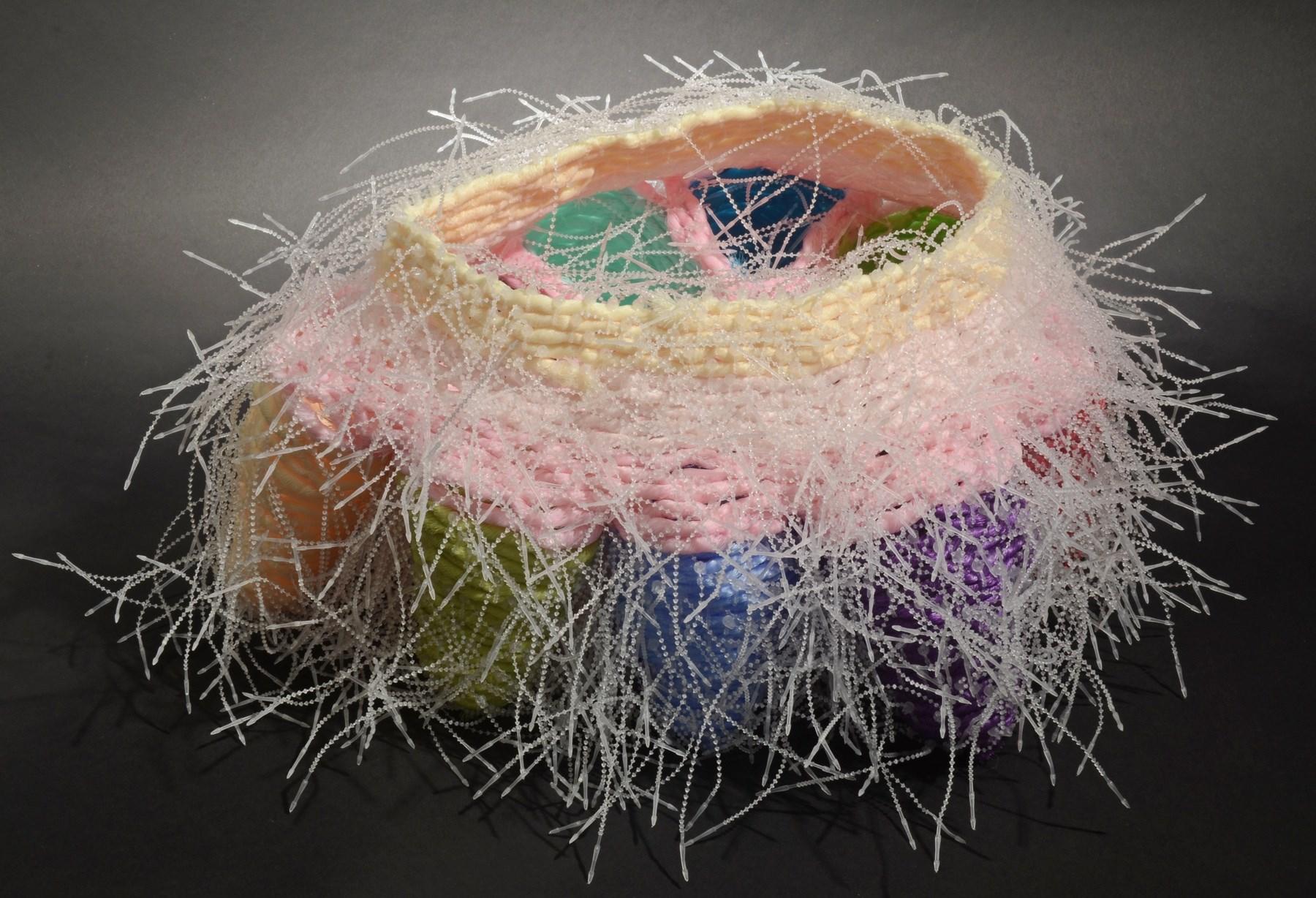
Many thanks to Gutfreund Cornett Art for the opportunity to review this exhibition and heartfelt thanks to each artist for contributing vital perspectives on such an interesting range of women’s issues.


16
Emily Dvorin Cleanse and Exfoliate Lynn Dau Disorder
SPOOKY BOOBS COLLECTIVE You Stupid Cunt
Artists Exhibited in Kaleid Gallery
Diyar Al Jazzi, Tara Booth, Nellien Brewer, Sara Cole, SPOOKY BOOBS COLLECTIVE, Katherine Collins, Lynn Dau, Emily Dvorin, Beth Fein, Lindsay Garcia, Yolanda Guerra, J Howard, Blond Jenny, Jennifer Jones, Joanna L. Kao, Marky Kauffmann, Eileen “Ikie” Nolan Kressel, Beth Lakamp, Mido Lee, Becca Levine, Kathryn McDonnell, Victoria Helena Mihatovic, Beverly Mills, Sarah Nguyen, Min Kim Park, Amy Pleasant, Michele Poindexter, Remedios Rapoport, Cherie Redlinger, Caren Helene Rudman, Sondra Schwetman, Nastassja Swift, Cynthia Tom, Natalie Waldburger, Ruth Waters, Corinne Whitaker, Janice Whiting, and Tina Ybarra.
17
Diyar Al Jazzi
San Jose, California
Silent Words
Acrylic on canvas
60 x 72 inches
2016
The women in my country are like statues placed in the corner of a room. They live in a country controlled by men, madness, racism and intolerance. Women are not allowed to talk or share their feelings. The women in my country are living in solitude, covered by a veil of darkness. The men do not want her to be seen nor heard. We are not less intelligent or a shame. We are to be freed and to live our lives freely. I will not be a black trash bag and no one can stop me.
18

19
How much can women endure both physically and mentally? How much is forced and how much is self inflicted? At what point does it all become too much?
20
Booth
Delaware
In(gest) Video 5:53 minutes 2015
Tara
Newark,
www.tarabooth.com
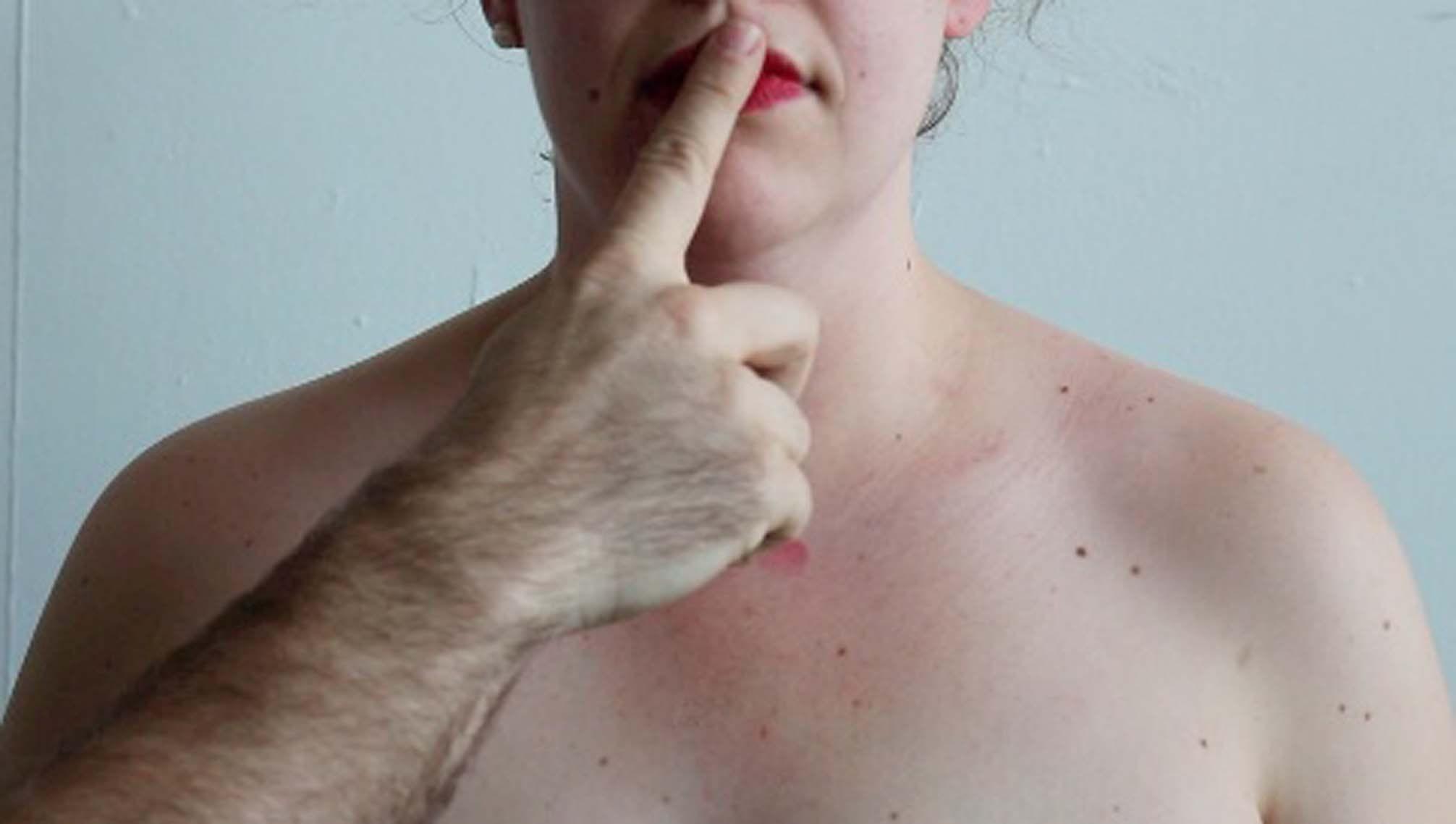
21
Nellien Brewer
Garden City, Kansas
www.art.co.za/nellienbrewer
Phoenix #2
Digital print on aluminum 24 x 16 inches
2009
Too many women in the 21st century are victims of abuse be it through human trafficking, modern-day slavery, child marriages, forced prostitution or other atrocities. In too many societies today, women are still treated as second rate citizens. Yet these women—from the barefoot granny raising her grandchildren on a meager pension, the lady in a slum working three jobs, to the AIDS orphan looking after her siblings whilst trying to cope with school—form the backbone of society. The work Phoenix #2 (2009) shows a decaying leaf. The delicate structure (and strength) of the veins are exposed as a result of the death of the leaf. Above the leaf is an ‘organism’ created from text which symbolizes the soul of the victim which is often only set free upon death.
22
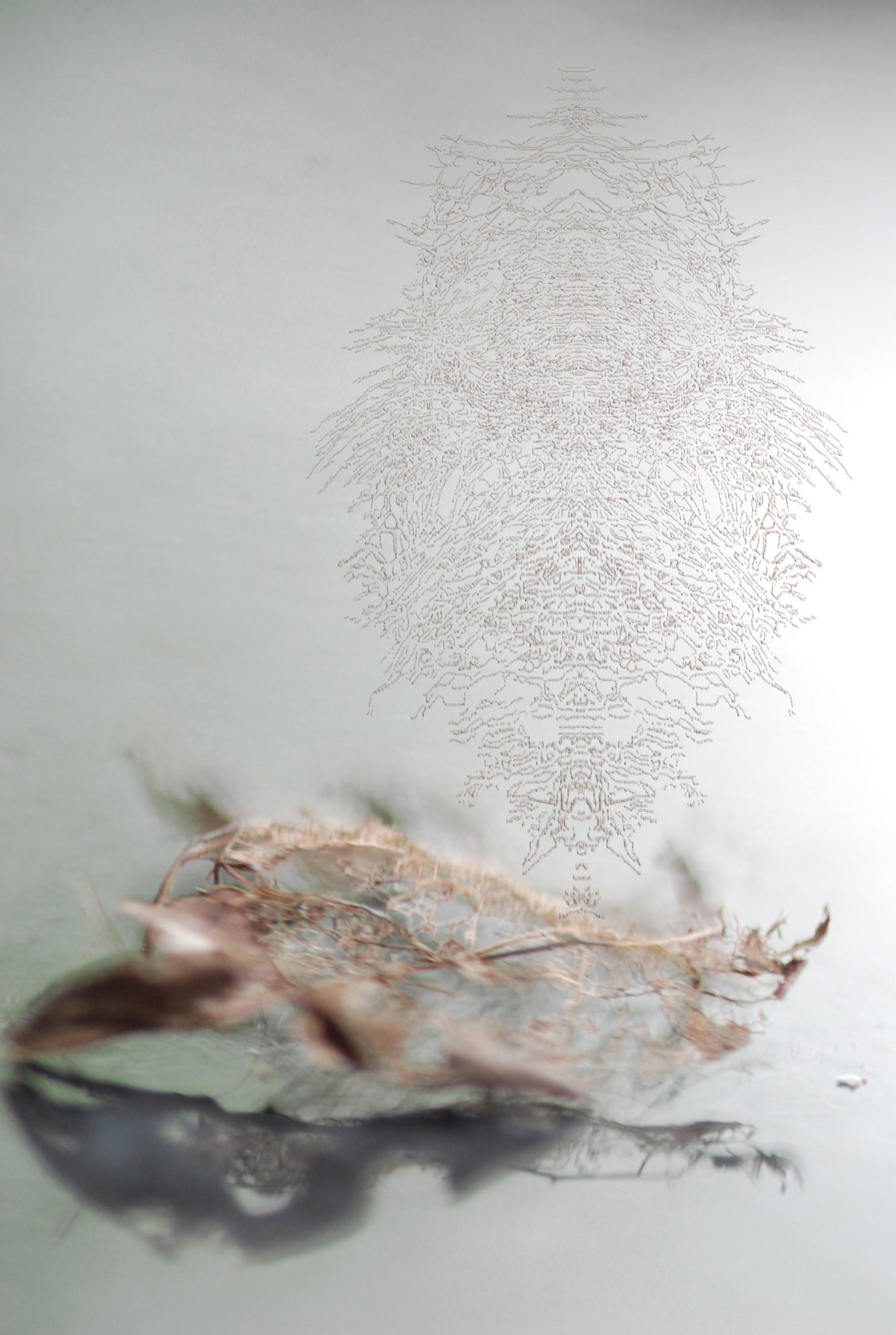
23
Sara Cole
San Jose, California
www.saravcoleart.com
Forgotten Women 2
Gesso, acrylic, graphite on paper 22 x 30 inches
2015
The Forgotten Women series visualizes the deterioration of a woman’s identity after sexual assault. This series is inclusive of the pandemic of global violence against women. The woman represented in this work has lost her sense of femininity and the act of the assault itself has permanently altered her perception from a “normal” world view to a vision of her surrounding filled with trepidation and hypervigilance.
24
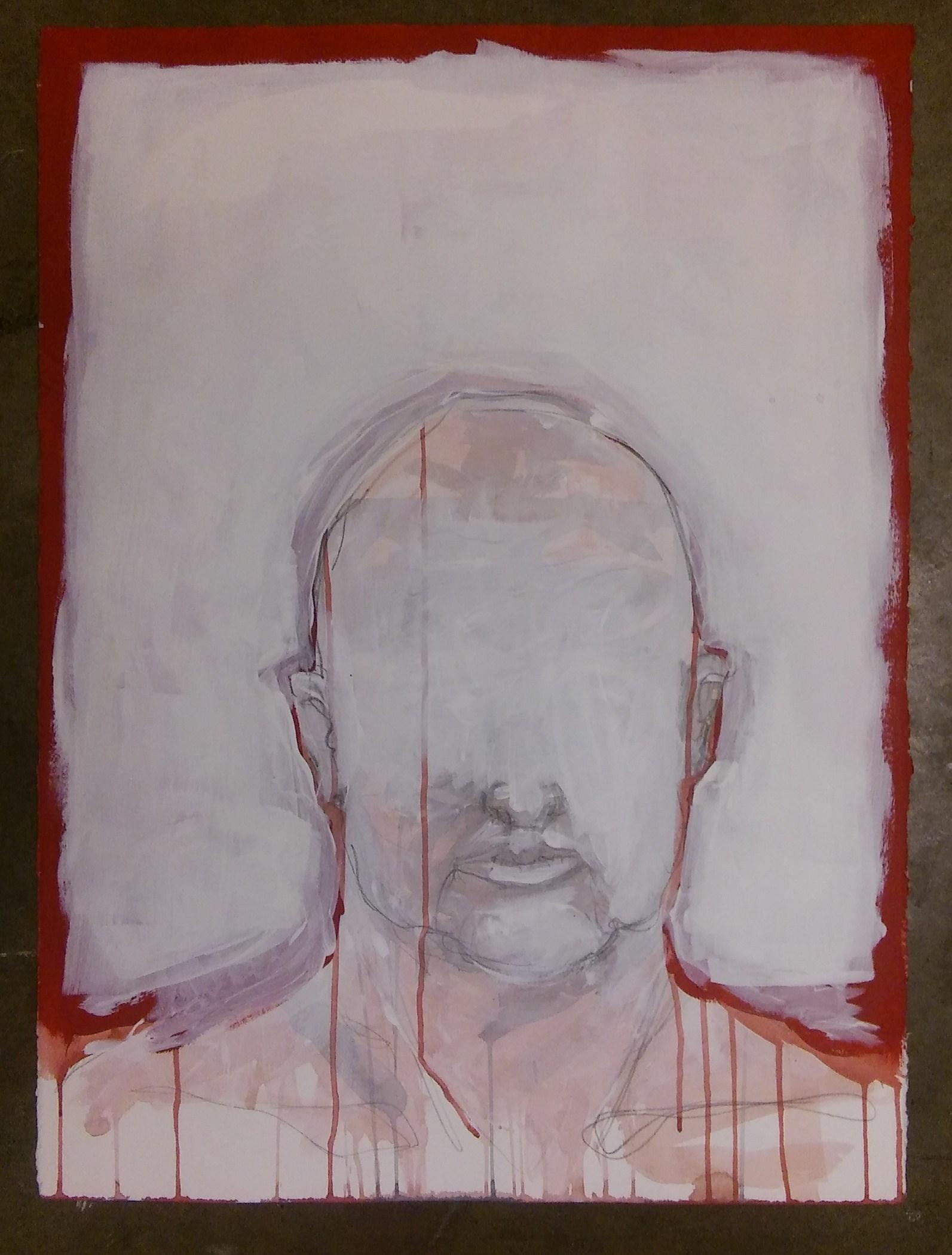
25
SPOOKY BOOBS COLLECTIVE
Madison, Wisconsin
www.spookyboobs.com
You Stupid Cunt
Peel and stick removable woven wallpaper
72 x 48 inches
2015
You Stupid Cunt is part of our current ongoing project, a series of subversive wallpaper patterns entitled The Patterns’ Vicious Influence. This series reveals the ugliness of our culture’s careless language habits through beautiful design. Our patterns are built using words that are used to diminish and minimize; these words range from descriptors that disregard our ideas (ball and chain, crazy, emotional) to names that attack our bodies and sexuality (cunt, pussy, bull dyke). The prevalent use of these words impedes progress towards social equality. The choice to use wallpaper design as a visual platform was influenced by the early feminist text The Yellow Wallpaper, a short story in which a women is driven mad by the social minimization of her identity.
26
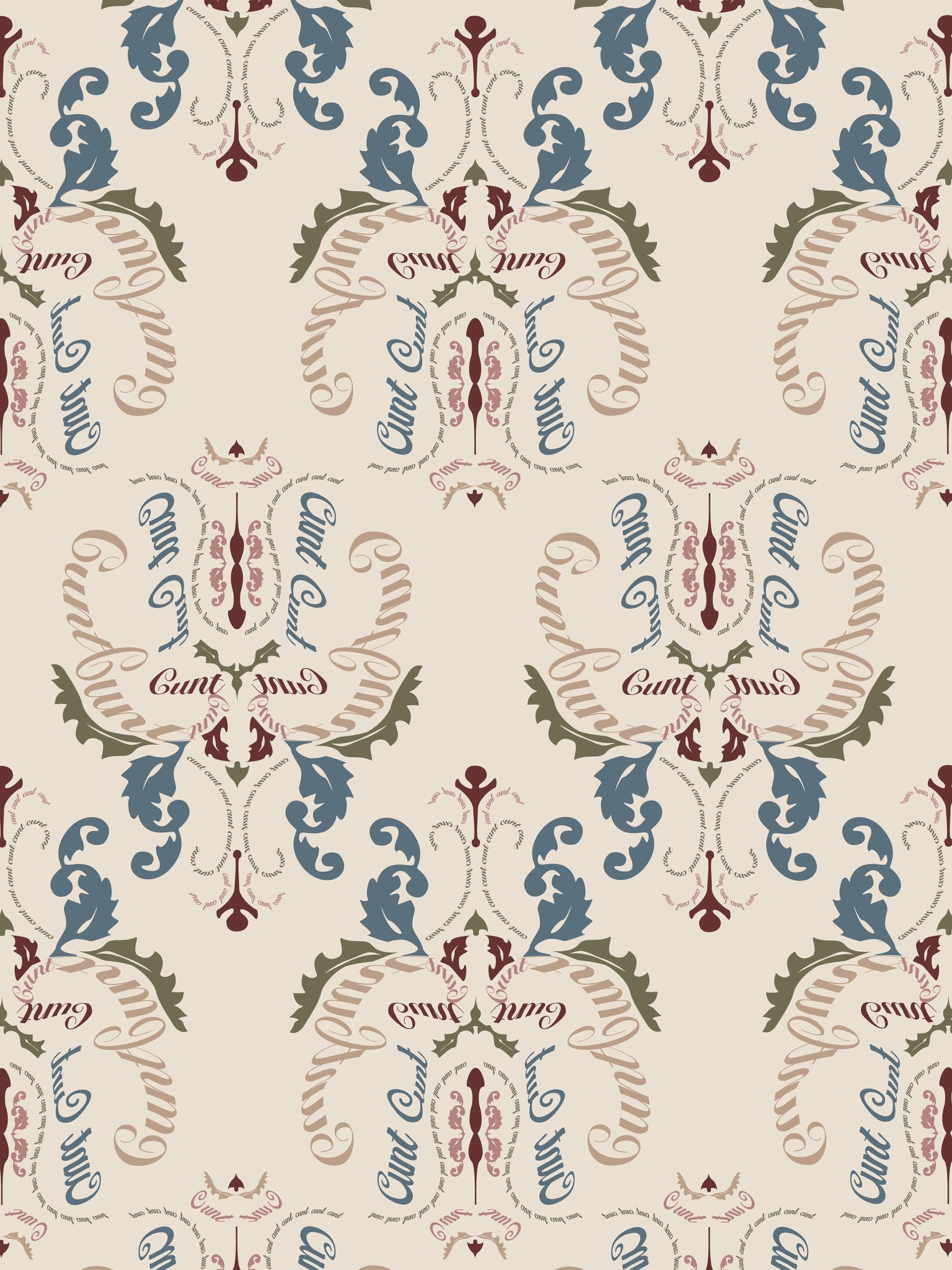
27
Katherine Collins
Springfield, Ohio
Alabaster
Oil on canvas
20 x 16 inches
2016
This painting is part of a larger series of work I completed while finishing my undergraduate degree, which I received just this spring. It is intended to explore concepts of identity and personality, and what we as humans tend to conceal or reveal to the world at large. I want its meaning to be fluid, able to shift for every person who happens to view it. In my eyes, it has the potential to open a commentary on many current global issues, including women’s rights, identity, gender and racial inequality, and cultural instability. So please always look at art, of any kind, with an open heart and mind.
28

29
Lynn Dau
San Jose, California
www.lynndau.weebly.com
Disorder
Found objects
36 x 30 x 35 inches
2016
This piece reflects the disorder in the current world order that values work outside the home more than work performed inside the home. Maintaining a household and raising children is just as demanding and challenging as many professions outside the home, but with no system of built-in monetary compensation the work is sociologically and psychologically undervalued. If we want to liberate both men and women so they feel just as comfortable choosing to work inside the home as out, then the job of homemaker and primary caretaker needs to be elevated to the same status as comparable professions outside the home.
30

31
Emily Dvorin
Kentfield, California
www.emilydvorin.com
Cleanse and Exfoliate
Deconstructed bath poofs, security ties
9 x 19 x 14 inches
2015
My sculptural basketry work uses re-purposed, re-contextualized materials as commentary on overconsumption of commercial goods, societal excess and throw-away consumerism. My vision is to see art in my everyday environment, choosing common, available materials and utilizing traditional basketry techniques in a non-traditional way. Here, I have coiled deconstructed bath poofs combined with beaded security ties to create cells, visually commenting on different aspects of the cleansing process.
32

33
Beth Fein
Berkeley, California
www.bethfein.com or www.danceanywhere.org
Speak Truth to Power
Archival pigment print on Japanese kozo paper (edition of 3) 100 x 44 inches
2013-2016
This work, Speak Truth to Power is part of a series of works I created called Voices, about the choices we must confront when faced with injustice. The images projected are a collage of personal memories of my family in Argentina during the military dictatorship, combined with images of those who had the strength and courage to protest against the military junta. There are also elements from the 1973 military coup in Chile. The Quaker phrase from the 1950s Speak Truth To Power is translated here into twenty-four languages, representing the need all over the world, for us to speak up and to honor those who have confronted repression with valor.
34
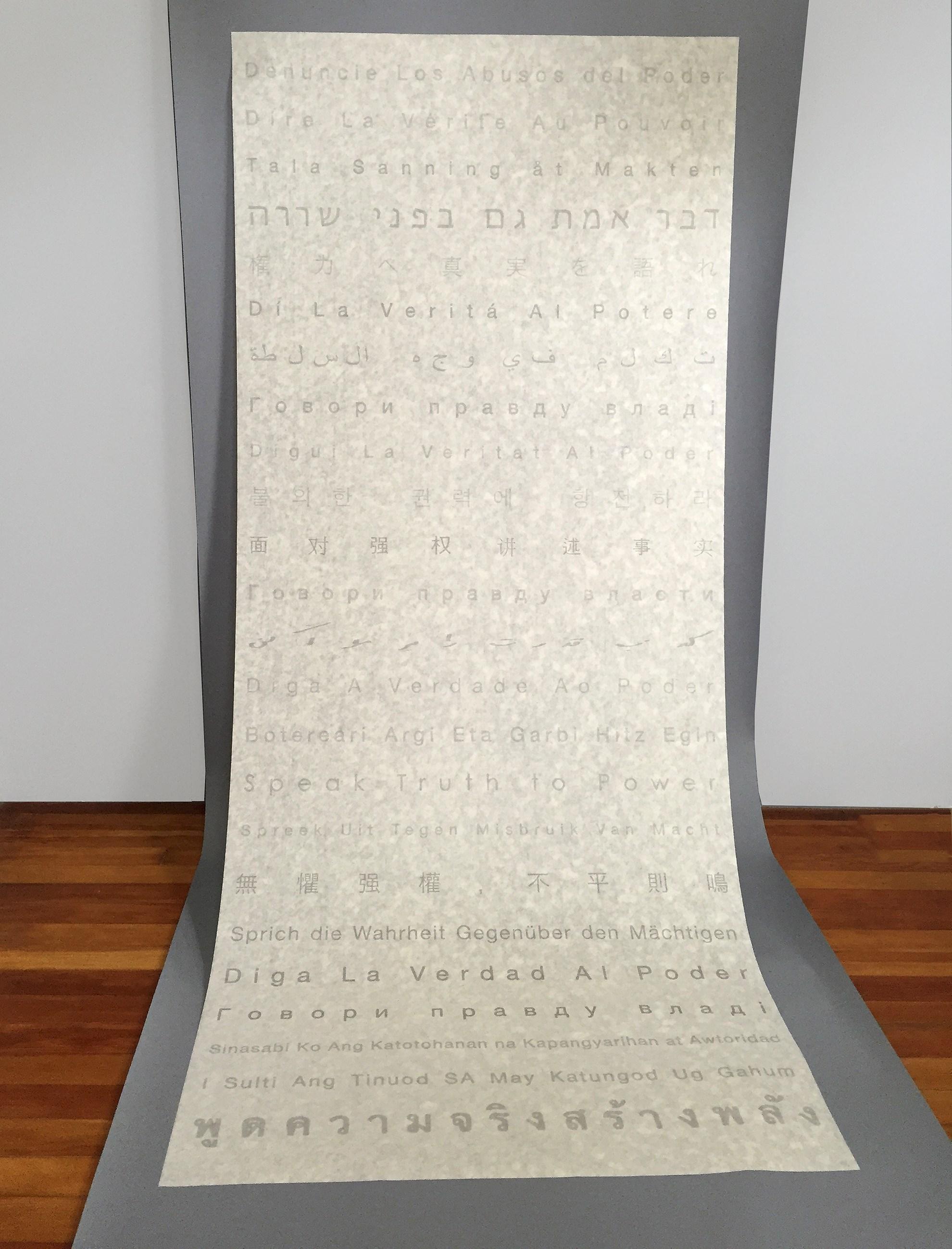
35
Lindsay Garcia
Rye, New York
www.lindsaygarcia.com
Pig & Chicken
Single-channel video
3:56 minutes
2016
Under a hot sun, two human women perform as humans, pigs, and chickens while forming interspecies relationships with two common American breakfast foods: bacon and eggs (also known as pigs and chickens). A shark looms in the distance.
36

37
Yolanda
No Strings Attached is part of a vagina series that I am working on that represents the breadth and depth of female sexuality as it relates to my personal experiences. This piece reflects the beauty, intensity and pleasure of sexuality that has no attachments to social norms, social and religious constraints, or psychological gymnastics of worry, fear, guilt and the need to make an experience into more than it already is. It is an understanding of pleasure that is given and reciprocated without attachment. It is a piece of female power at the moment of sheer pleasure and joy.
38
Jose, California
Guerra San
www.yolandaguerra.com
Mixed media 10 x 10 x 3 inches 2015
No Strings Attached

39
Alvin, Texas
organicpastels.com
Drowning In Emotions
Organic soft pastels on natural canvas
24 x 24 inches
2015
Drowning In Emotions is a portrait in nature softened considerably through abstraction with an appreciation of the rhythm and separation of light and dark. Being more emotionally charged, it is meant to drive you to a place deep within yourself, much like the subject appears beneath the depth of the water. The darkness of the water, coupled with whether she is rising or falling, creates a sense of insecurity amidst the obvious presence of the unknown. Yet her face thrives with vibrant color and intensity that could only represent self awareness and victory over adversity and conflict.
40
J Howard

41
Blond Jenny
Long Island City, New York
www.blondjenny.com
American Woman
Pigment print
30 x 40 inches
2016
My character Blond Jenny represents an American Woman and her equality in society. I use a mask for anonymity so that she can become me, you, or anyone who wants to become like her. The oriental flower blossoms with the American flag dress combine my unique experience into a cohesive expression of womanhood.
42
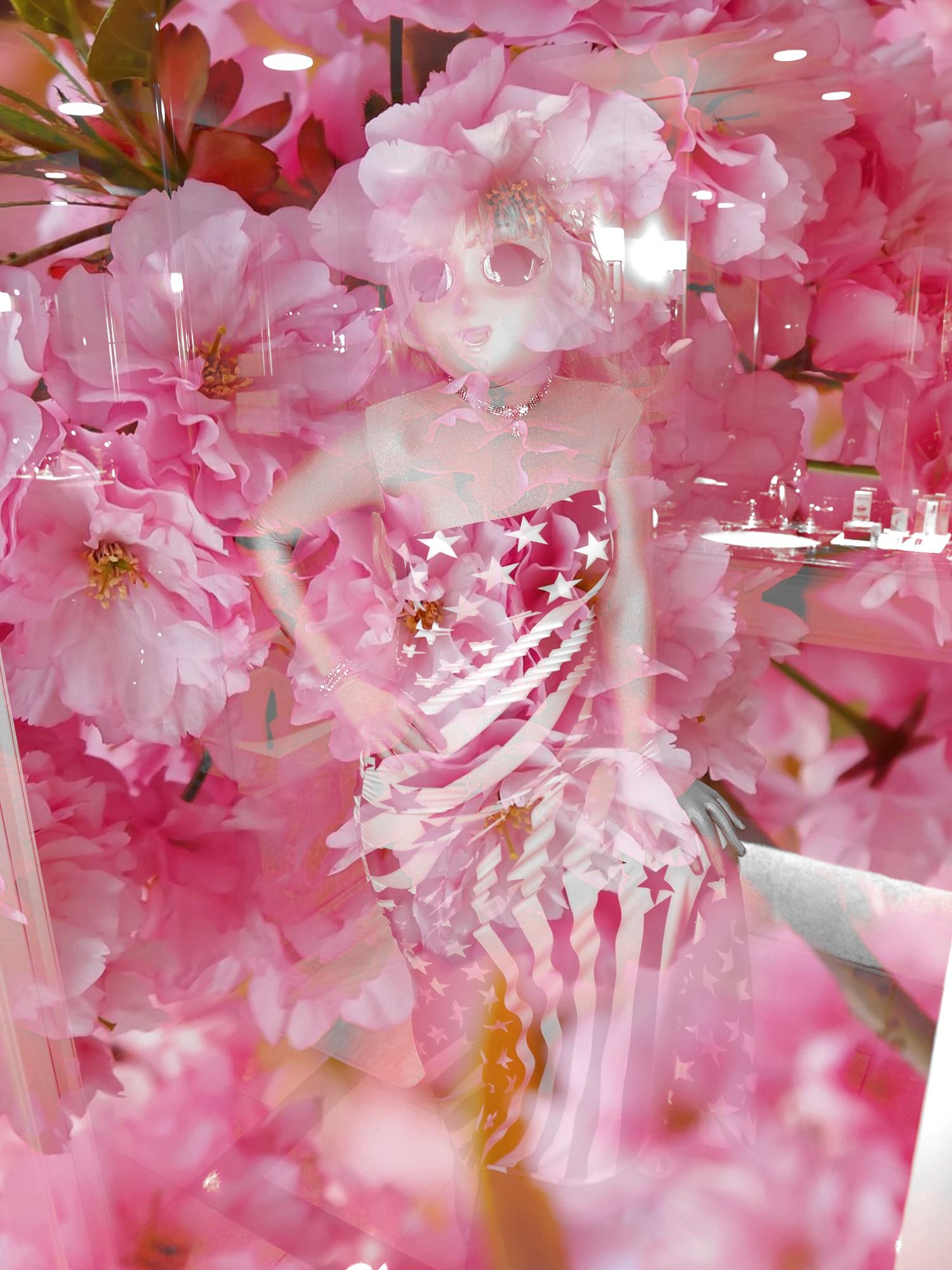
43
Jennifer Jones
Delta, Colorado
www.jenniferlart.wix.com/artportfolio
Elysium
Stainless steel with embroider thread 9 x 6 x 11 inches
2016
As a woman who is always in moments of transition and states of almost-but-not-yet, my interest is to create sophisticated minimalist work that is a reflection of these times. Inspired by natural patterns and colors found in fashion, architecture and nature, I create minimalist and abstract shapes that are the essence of beauty, peace and strength. By combining the rawness of the canvas and fibers with the hardness and stubbornness of the metal, my works are a testament to what it means to be a woman in these uncertain times whose softness and peacefulness is in knowing her strength.
44

45
Joanna L. Kao
Berkeley, California
The Source: to Look at the World through Women’s Eyes
Painting and collage
27.5 x 19.5 inches 2014
It is women in most societies who are generally more involved in raising the children. Education of a woman is not wasted: she will in turn pass on to her children what she has learned. It is an affirmative means of achieving equality among women and men for the long term survival and advancement of human society.
46

47
Marky Kauffmann
Shirley, Massachusetts
www.markykauffmannphotography.com
Lost Beauty: Burns Facial Wrap
Archival pigment print 24 x 16 inches
2012
potassium ferricyanide. I use the bleach symbolically. It is my metaphorical
48
This portrait of an aging woman was bleached with
representation of all the procedures women feel compelled to undergo to reverse the signs of age.
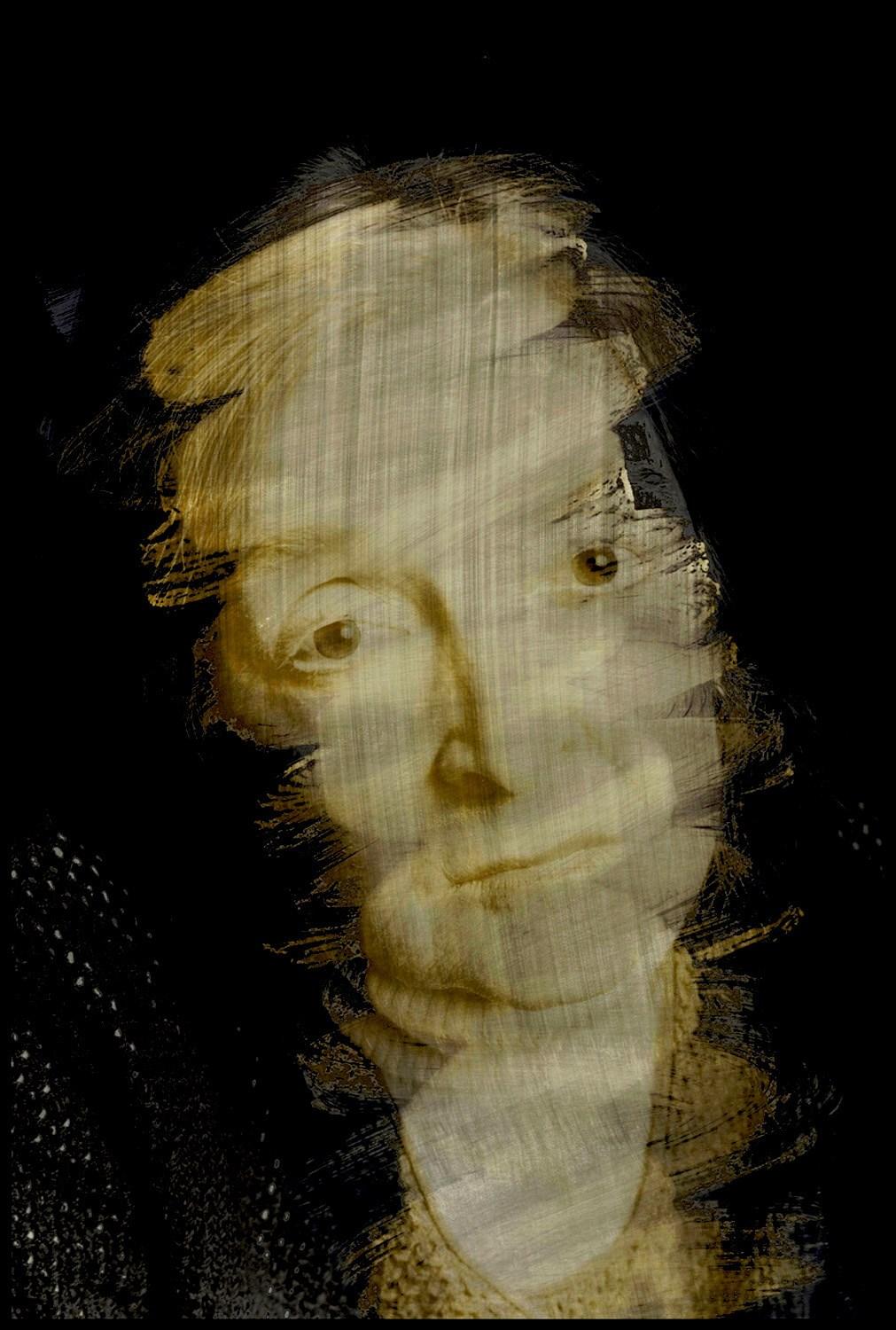
49
www.enkart.net YES
This piece reflects the unpredictable and turbulent times in which we live, but not without a sense of hope. Together, with hands outstretched, we reach for and believe in a better future. The text is from a William Stafford poem, entitled “YES”; ...”no guarantees in this life, but some bonuses, like morning, like right now, like noon, like evening.” As long as there is art, there is hope.
50
Eileen “Ikie” Nolan Kressel
Portland, Oregon
etching
22
Two color
28 x
inches 2005

51
Beth Lakamp
Fenton, Missouri
www.bettsvando.com
Rickety Lawn Chair in Happy Gardens
Water color on clay board panel
10 x 8 inches
2016
Retirement is supposed to be a time of relaxation, reflection, and enjoyment and not a struggle to meet basic everyday needs. Rickety Lawn Chair in Happy Gardens is a representation of the disproportionate amount insecurity that many women face in retirement.
52
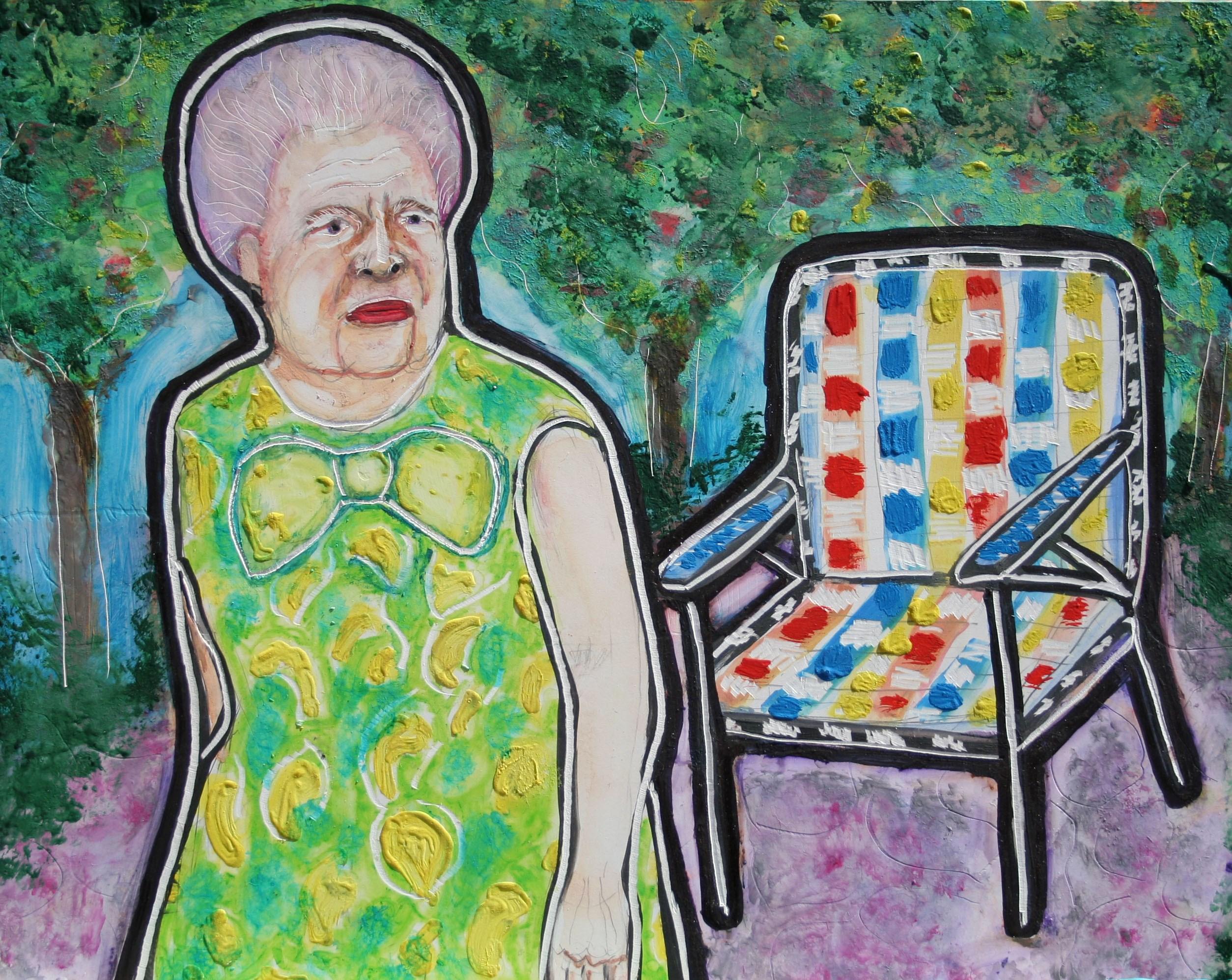
53
San
www.midoleeart.com
Cyberbullying created a devastating, soaking coldness in my chest that I couldn’t shake off for months. Its inhumane quality isolated me from all the warmth in this world.
54
Lee
Mido
Francisco, California
wouldn’t shut tje fuck up Archival digital print 30 x 24 inches 2016

55
Becca Levine
Willington, Connecticut
www.beccalevine.com
Lost Cause
Recycled tire soaker tubing
23 x 50 x 25 inches
2016
Vision is the recognition of perspectives beyond one’s own. Lost Cause was formed by making use of compulsive knotting that in any other context would be viewed as dysfunctional behavior. The piece transitions from being tightly controlled and geometric to becoming looser and more organic.
56

57
Kathryn
McDonnell
Washington, District of Columbia
www.kathrynmcdonnell.com
Chibok Girls Color
Digital print
30 x 16 inches
2016
On April 14 2014 approximately 276 school girls between the ages of 16 and 18 were kidnapped from a school in Chibok, Nigeria by the terrorist group Boko Harum. Some of the girls managed to escape while the remaining 178 are still missing. Boko Harum uses sexual violence as a weapon of war by raping and forcing the girls into marriages or sold as slaves. Two years have passed and the girls have not been returned. Chibok Girls brings attention to the use of sexual violence as a weapon of war. Missing girls are listed by name.
58

59
Maternity Wear encourages the viewer to imagine the weight held over women in regards to their fecundity and traditional gender roles. This plays out through reproductive justice issues with access to healthcare and used as an instrument in historical atrocities against marginalized groups. Conversely, those that are privileged with a choice of childfree lives often suffer shame within a constant tension and expectation of becoming a fully realized individual. Motherhood in our modern society, as much as it is an exaltation of the Other, has also served as a way to remove agency over female bodies and lives.
60 Victoria Helena Mihatovic Santa Rosa, California www.victoriahelena.com
Wear Cast aluminum 28 x 19 x 9 inches 2013
Maternity

61
Beverly Mills
San Francisco, California
www.studiobeverly.com
Haunted Sanctuaries 50 Paper and found images 25 x 20 inches
2015
How can I endure the earth? Will a scar form? Will I be safe? Will you help? If not, what life are you living? When did you become that person?
62

63
Sarah Nguyen
Warrensburg, Missouri
www.sanguyen.com
How does your garden grow? Card board, paper, glue, ribbon 5 x 7 x 3 inches
2014
How Does your Garden Grow? consist of one accordion folded book and two Jacob Ladder books. One side of the Jacob Ladder’s books contains printed images of my original paintings of plants, which have been used to assist abortions and the other side has information of how each plant was used in abortions. The accordion folded book has information on the history of the laws passed in the United States, which regards women’s reproductive rights. These books are not meant to guide or instruct women on how to obtain abortions through these particular means. These plants are not viable options to reproductive health. They are meant to only be impressions of the past and predictions for the future.
64
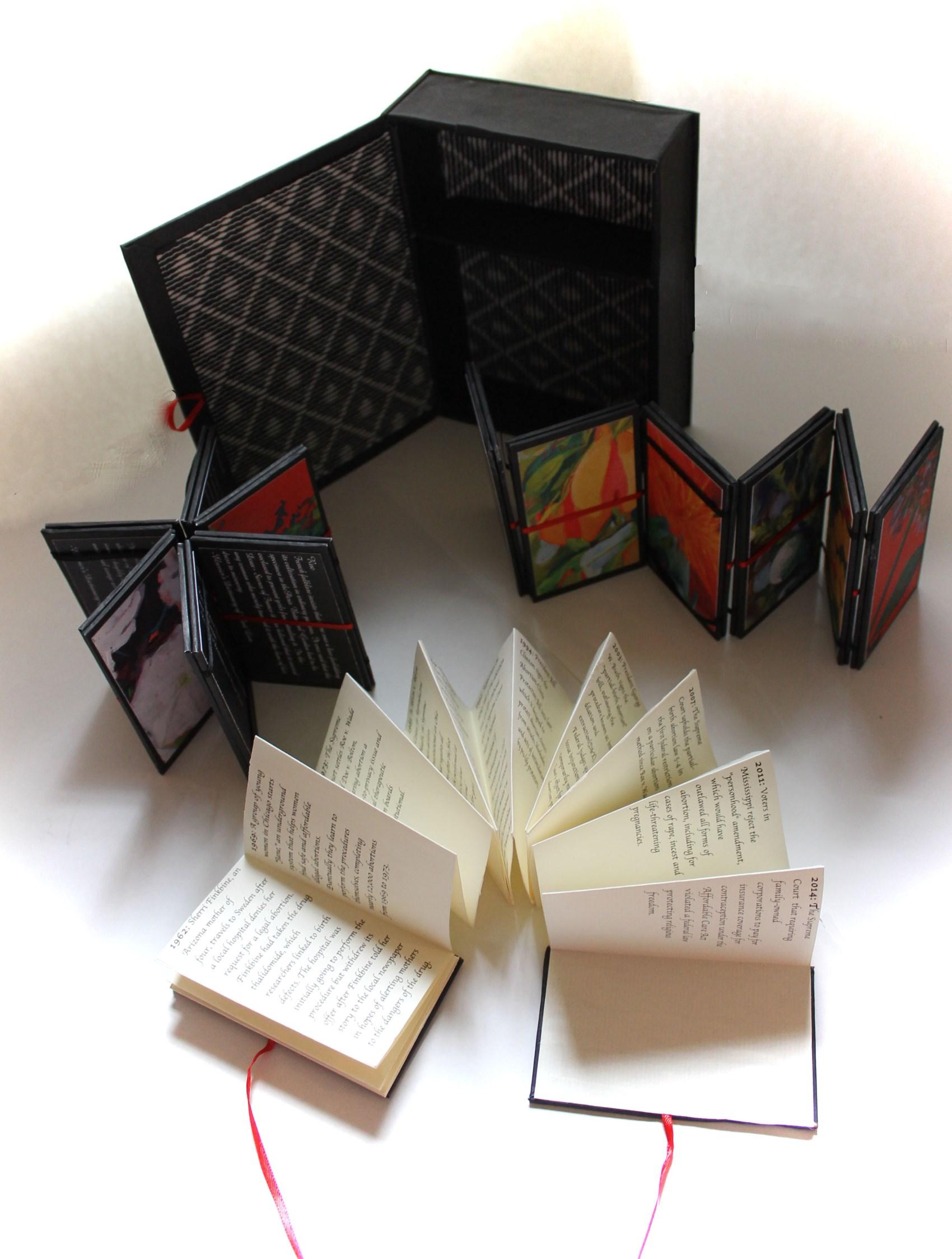
65
www.minkimpark.com
Contrived Spectacle
Archival
2015
Contrived Spectacle features Korean women in their traditional cotton jacket and skirt in various poses and gestures from their everyday activities such as washing the laundry, babysitting with baby in their back, working in the field. However, these poses also bear the symbolic images of the ideal Korean women (or mother) as passed down from past generation and structuralized within the society as the bearer of nobility, selfless sacrifice, compassion and beauty.
66
Min Kim Park
West Lafayette, Indiana
inkjet print 30 x 25 inches

67
Amy Pleasant, the artist, creates a body of work rooted in her personal experience as a survivor of childhood sexual assault at the hands of a group of teenage boys. The result is an exploration of trauma, healing and the nature of memory; the adult looking back as an observer applying visual language to a life changing event in the woods. This piece serves as a return to the explicit moment of the event and daring to repeat the thoughts embedded in the trauma.
68 Amy Pleasant Seattle, Washington
in
Mixed media collage on cradle board 10 x 8 inches 2016
www.amypleasantseattle.com Voices
Her Head #1

69
Michele Poindexter
Rockwall, Texas
www.michidianephotography.com
Photosensitivity
Archival inkjet
16 x 20 inches
2015
As a self-portraiture photographer, I use my artwork to help cope with having Systematic Lupus Erythematosus (SLE) and the struggles of going through it with my identical twin sister. I highlight the shared experiences we go through as well as the private moments I go through alone. I use my artwork to shine light on the issues of lupus and how autoimmune diseases are rising by Americas malnourished diets. I have adjusted my lifestyle to cope with this issue but I hope to show others the symptoms and trials that come with lupus in hopes to allow a hard to diagnose disease bring more people to rest over why their body is turning on them.
70
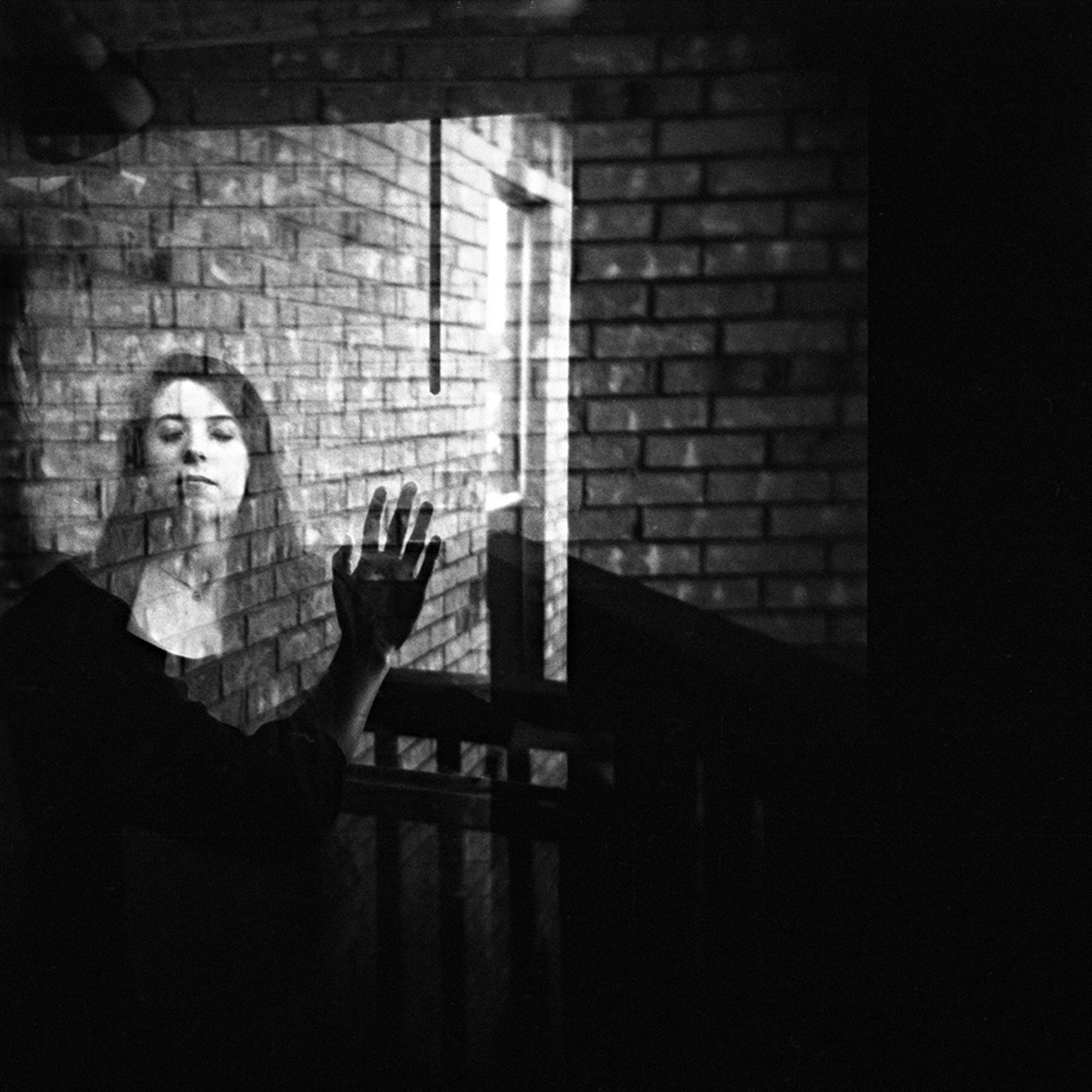
71
Remedios Rapoport
Portland, Oregon
www.remediosrapoport.com
Try to See
Oil alkyd painting on shaped wood with holographic glitter, 23k gilding and mirrored ball
27 x 27 x 9 inches
2010
Trying to see your self, externally and internally, can be difficult. Like looking into a mirrored ball, the closer you get the harder it becomes. With poetic playfulness the words can be read multiple ways to support concepts of self-awareness and global interconnection. Lettering disguised as puzzle pieces calls us to become “a part of the whole, a fraction of reality” where we can find ways to speak our minds, act in collaboration or alone, to effect positive change for ourselves and our world into the future.
72

73
Cherie Redlinger
Alexandria, Virginia
www.cheriemredlinger.com or www.cmr.photograhy
Abortions Provided In Back Alleys
Photograph
23 X 30 inches
2015
Abortions were performed in back alleys before 1973 when abortions became legal in the USA to save females from death caused by illegal abortions. Let’s not repeat history when 40,000 young girls and women died in United States and not counting who were maimed due to botched abortions a year caused by metal hangers or knitting needles that were inserted in them to rupture the lining and then cause bleeding. Keep abortions safe for young girls and women and not hear the last breathes from girls and women in back alleys.
74

75
Caren Helene Rudman
Highland Park, Illinois
www.carenhelenerudman.com
Is It Mine?
Canvas sheet, photography, paint, fiber paper, pastels
24 x 18 inches
2015
Is
It Mine?
depicts the disconnect between mind and body in the face of disease or circumstances outside our control. It portrays the depth of loss in relationships and in life. There exists an unprotected vulnerability that arises out of feeling powerless. However, at the same time, as women, we hold on to the hope of past and future generations, to value the strength that flows in our veins, and to empower us to overcome obstacles.
76

77
Sondra Schwetman
Arcata, California
www.sondra-schwetman.com
Plumb Boobs
Mixed media - wool, steel
6 x 6 x 4 feet
2009
The materials are chunky Icelandic “bubble gum pink” yarn knitted into forms for boobs; and powered coated steel stands to serve as gravity reminders. The weigh and direction of gravity, plumb lines using plumb bobs. This work is part of my vision: to gently direct people towards an understanding of the feminist journey. I employ many feminine forms from my symbolic lexicon ranging from the actual body to more abstracted forms such as Plumb Boobs.
78
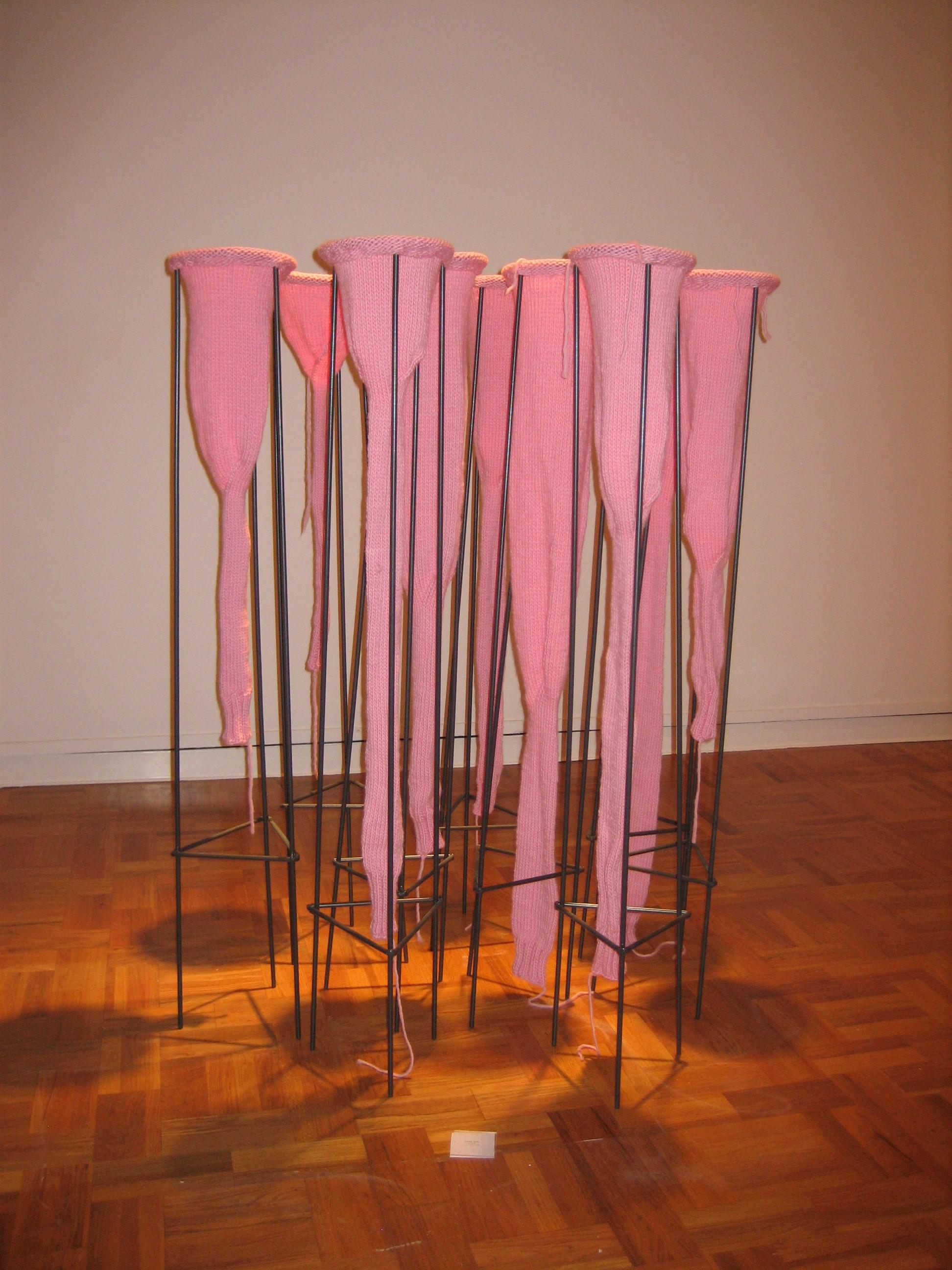
79
Nastassja
www.nastassjaswift.com
Now You Can Touch My Hair
Synthetic
Alluding to feelings of doubt and anxiety, my work highlights struggles with skin tone, speech and hair that I experience as a black woman and artist, and how I process and cope with those struggles. Now You Can Touch My Hair confronts the notion of black hair as a spectacle, or something for others to pet, and at the same time embracing the fact that, sometimes, the hair on my head isn’t actually mine.
80
Swift
Virginia Beach, Virginia
hair, cotton
x 12 x 1.5 inches
9
2015
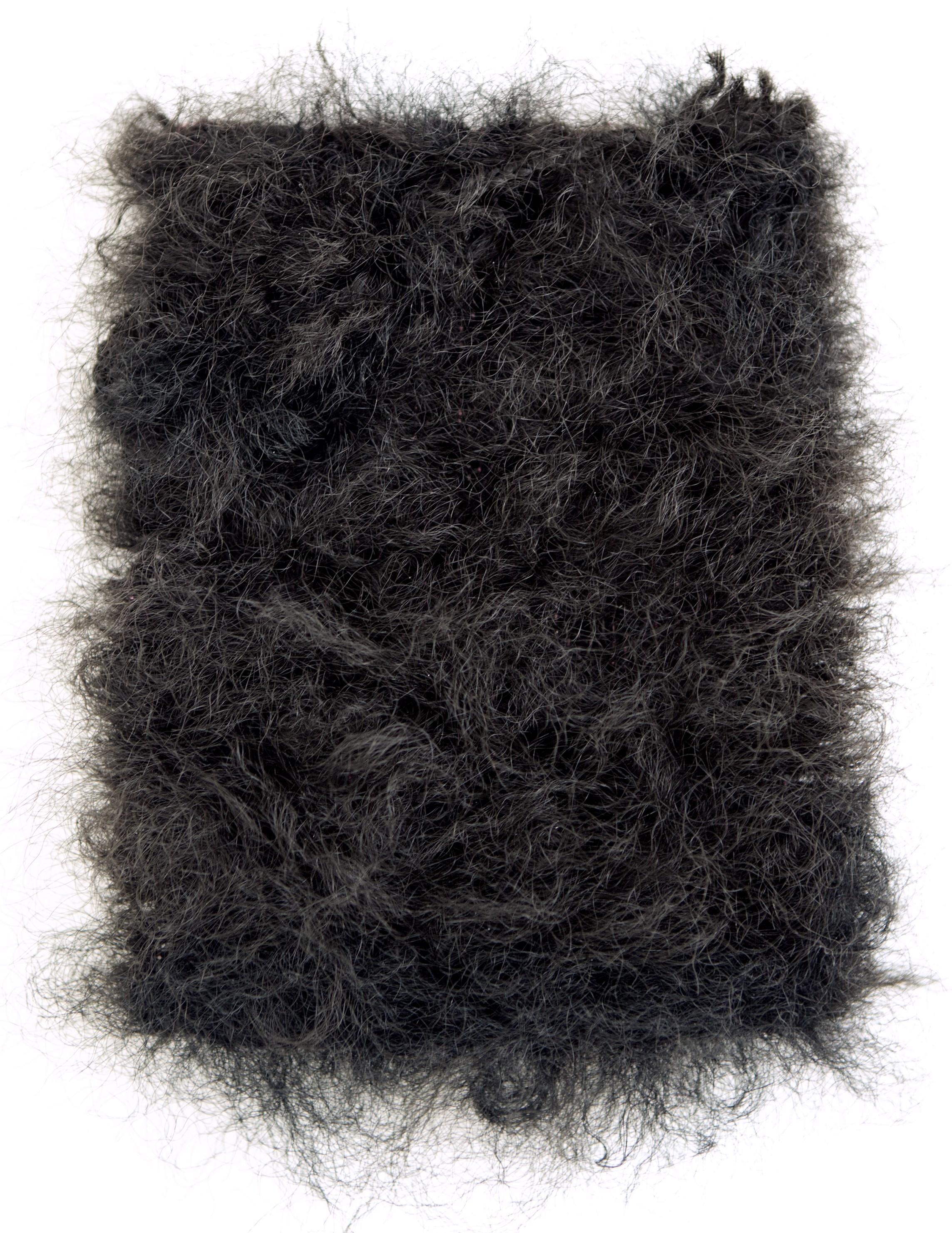
81
Cynthia Tom
www.cynthiatom.com
Intuition of Home
Intuition of Home is a non-verbal attempt to deal with the rapidly changing landscape in San Francisco. The loss of creatives and creativity in San Francisco has continued to leave open wounds and scars in Cynthia’s psyche. She uses her paintings to subliminally suggest a more empowered future for the women of this planet. She uses color and strong imagery to command attention and evoke empathy and calls to action.
Whether Cynthia pulls from her collection of found image memories in her paintings or chooses to build with actual three dimensional objects as sculpture, she creates relying on her intuition and strength of intent to turn these disparate pieces into compelling lucid stories.
82
San Francisco, California
on canvas
x 30 inches
Acrylic
48
2015

83
Natalie Waldburger
Toronto, Ontario
www.nataliewaldburger.squarespace.com/
Not a Codeable Disorder
Encaustic on panel 15 x 15 x 4 2013
With the release of version 5 of the Diagnostic and Statistical Manual of Mental Disorders, or DSM-5, arrives a plethora of questions about the structures we rely on to quantify and qualify our understanding of mental illness. Controversy has always surrounded this psychiatric tome, the international standard classification manual of mental disorders, because of its power to diagnose non-normative behaviour as psychiatric abnormalities. These aberrations are categorized as clinical and potentially treatable. That social values are constantly shifting makes any such formalization of human behaviours and their diagnoses narrow and culturally specific, at best. At its worst, these categorizations are destructive to vulnerable groups in society. The clinical codification and institutionalization of this manual has too often been used to institutionalize misdiagnoses and mistreatment of gender and racialized groups.
84

85
Ruth
Exploring the human condition how we relate to ourselves and to others has been the major focus of my work for more than 50 years, and will no doubt continue to absorb me. The possibilities for visual commentary on existence and relationships are infinite, not only in subjective content but in the range of stylistic interpretation. By and large, my sculptures are commentaries on humanity, observations of individuals, and reflections on universal truths. I sculpt in the classic subtractive mode, using mallet (or maul) and chisels on hardwood logs and blocks of marble, followed by lots and lots of sandpaper.
86
California
Waters Belmont,
Ash
x 22 x 13 inches 2006
www.ruthwaters.com Interaction V
96

87
Corinne
Whitaker
Foster City, California
www.giraffe.com
Woman With Red Gloves
Aluminum 40 x 40 inches
2015
We are not Barbie. We are not objects of porn, or scorn. We envision ourselves in bold new ways, forging a new future from the inside out. We will succeed, because we know we can. Will you join us?
88
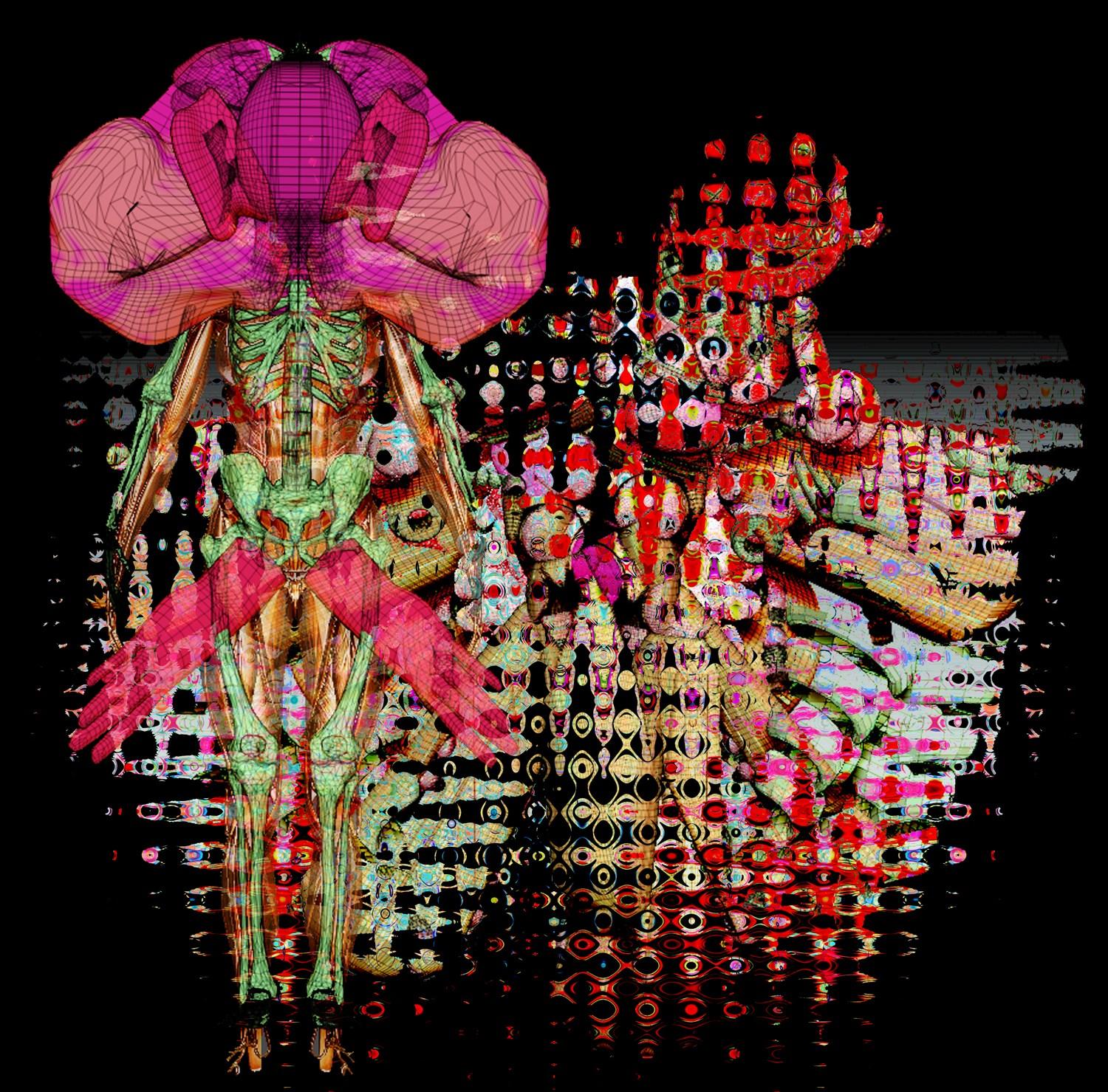
89
Janice Whiting
Augusta, Georgia
www.janicewhiting.com
Three Ages of Women
Charcoal, pigment, oil, alkyd on canvas
30 x 39.5 inches
2015
All women in U.S. society are faced with constant borage of messages about beauty and sexuality telling them that in order to be desirable they must emulate the characteristics of both innocence and overt sexuality. This contradictory approach to feminine value is best summarized in what is known as the “Virgin/Whore” dichotomy. This dichotomy is amplified as women age and our society, our daughters and even their contemporaries are quick to point out all the socially defined imperfections of age as if they are ugly scars that make others feel uncomfortable when exposed. All of this ignores the fact that a woman’s sexuality does not disappear at age 30, 50 or 70 and that to be woman is to be beautiful.
90

91
Tina Ybarra
South Gate, California
www.tybarra23.wix.com/tinaybarra-artshow
She’s More Than What You See
Graphite on paper
12 x 9 inches
2016
In this piece She’s More Than What You See, a partially drawn face represents how women are viewed in today’s society. Despite all our advances, the lack of equal pay, reproduction rights, respect, and so on prove that women are still not viewed as whole human beings. She’s more than what you see. Yet for those who cannot see beyond a pretty (or not so pretty) face or a stereotype, her totality will never truly be seen.
92

93
94
Artist Slideshow at Kaleid Gallery
Salma Arastu, Lynn Arnold, Joanne Beaule Ruggles, Andrea Borsuk, Andrea Broyles, Carolyn Cohen, Linda King
Ferguson, Anitra Frazier, Sara Friedlander, Sara Gallo, Caryl Gaubatz, Linda Gleitz, Tricia Grame, Georgie
Humphries, Uma Rani Iyli, Olivia Jane, Kathryn Jill Johnson, Thuy Linh Kang, Kristin Kempa, Sameh Khalatbari, J.L. King, Epiphany Knedler, Susan Kraft, Biljana Kroll, Krista Machovina, Stela Mandel, Juliet Mevi, Jennifer
Mondfrans, Shabnam Mottaghi, Jelisa Peterson, Sara Petitt, Lorena Pugh, Trix Rosen, Gerri Russell, Pallavi
Sharma, Marlene Siff, Sean Sterzer, Elka Stevens, Kim Tepe, Diana Tremaine, and Laurel Luckey with Jennifer Weigel.
95
Salma Arastu
Berkeley, California
www.salmaarastu.com
Mercy for All, Acrylic on canvas, 50 x 70 inches, 2015
I find myself yearning to find infinite possibilities of the lyrical line itself on large canvases. I just want to plunge myself into the pleasure of contemplating the abstract flow of the swelling lines, and form compositions of lines and fields within given space and enjoy the celebration of calligraphy through lyrical visions. The energy and movement of Arabic Calligraphy, powered by the positive messages from the sacred text has inspired me to create these new paintings.

96
Lynn Arnold
Ada, Michigan
www.lynnarnoldup.com
Paper hose, Mixed media on paper, 11 x 14 inches, 2016
My drawing, Paper hose depicts the fragile and sometimes superficial nature of women’s attire.

97
Joanne Beaule Ruggles
San Luis Obispo, California
www.beaulerugglesgraphics.com
No Simple Choice, Acrylic on stretched canvas, 36 x 24 inches, 1996
There is no such thing as a simple choice. Women must be allowed to look inward. All of our decisions impact our lives as well as the lives of others. The critical thing is for each of us to have the right to decide what is the meaningful path for our life, and to accept the consequence of that decision
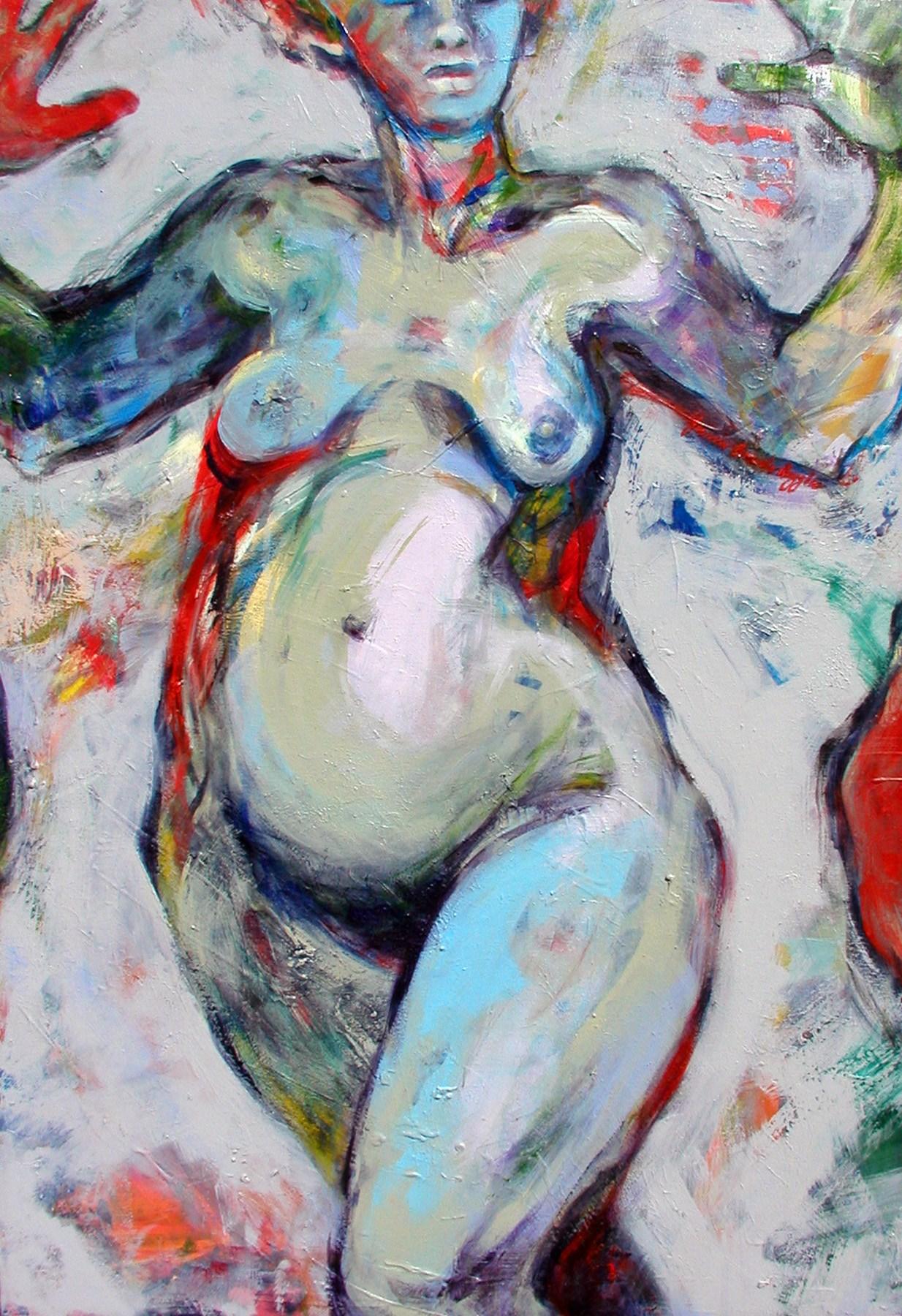
98
Andrea Borsuk
Santa Cruz, California
www.andreaborsuk.com
Tornado Ensuing, Gouache on Paper, 24 x 11 inches, 2015
This work is about time and place, the unpredictable, the precarious and the repetitive. Each image represents a specific event or archetypical phase we pass through in life. I am interested in the simultaneity and randomness of milestones as well as those unspectacular instances in between.
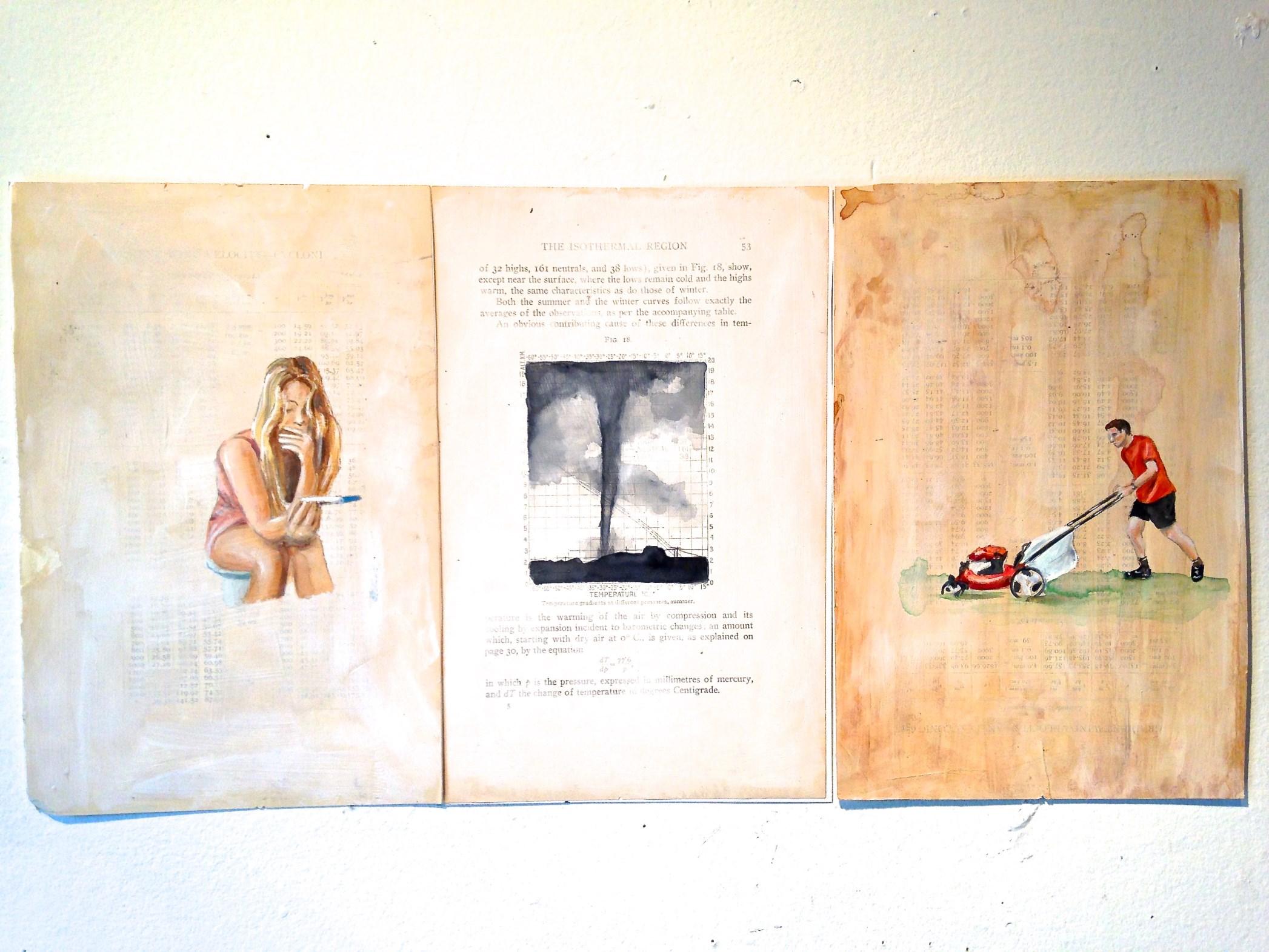
99
Santa Fe, New Mexico
www.andreabroyles.com
My work is concerned with the emancipation of the psyche as well as the physical body. In Figure With Gold, the figure has momentum in a seemingly confined space. In this piece, I portray a struggle but one with a positive end.
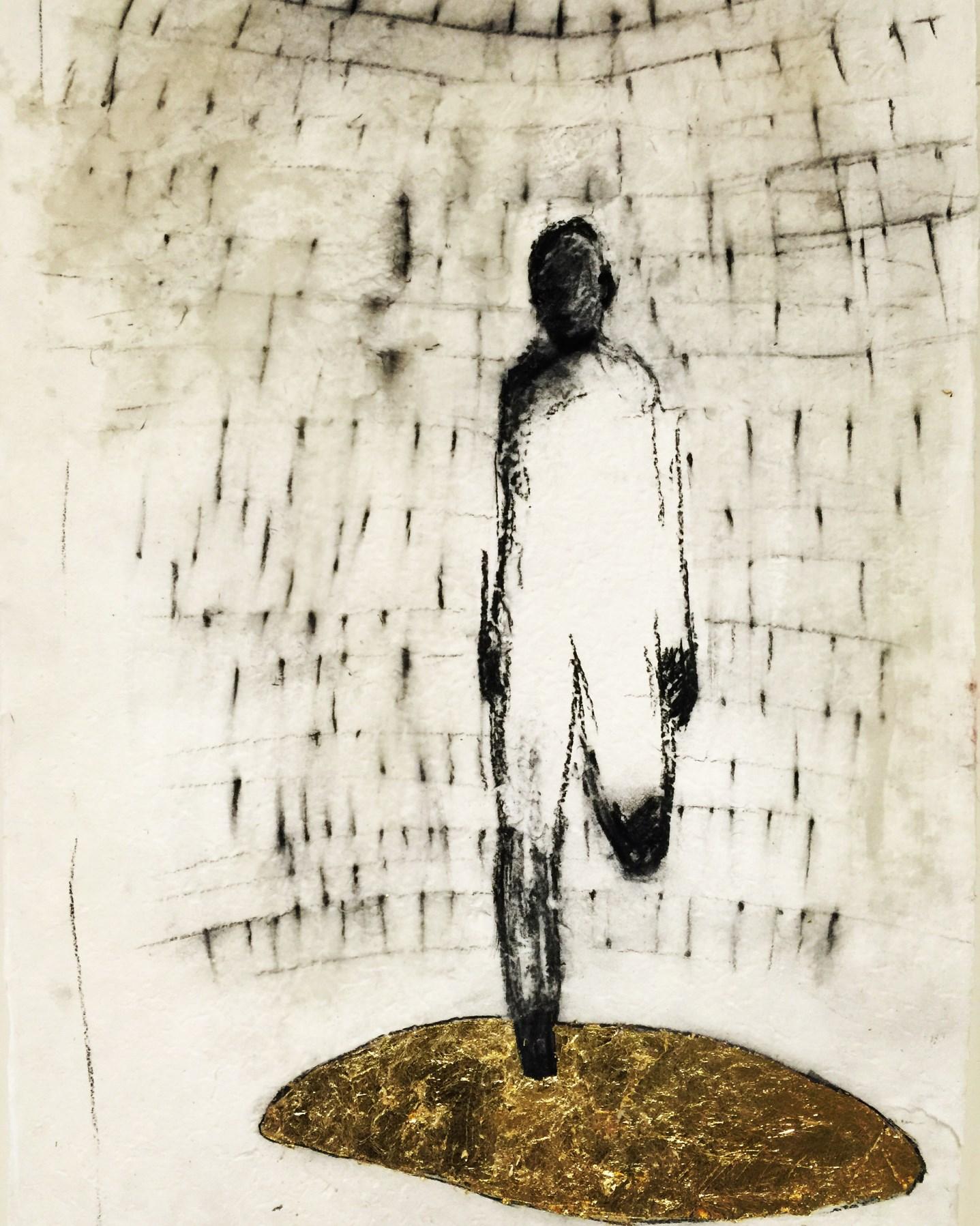
100
Andrea Broyles
FIGURE WITH GOLD POOL, Gold leaf, charcoal, 22 x 30 inches, 2016
Narberth, Pennsylvania
www.Carolyncohenart.com
Mask (Irum Saeed), Hand embroidered batik, watercolor, marker, 24 x 18 inches, 2015
My work bears witness to the brutalization of women, children and LGBTQ individuals throughout the world and comments upon the blind eye that is turned to those who are suffering. They provide faces to those who are faceless, nameless and powerless, thus providing a vision for a more positive future.

101
Carolyn Cohen
Linda King Ferguson
Au Train, Michigan
www.lindakingferguson.com
Equivalence 16, Acrylic and acrylic stain on cut stretched linen, 20 x 20 inches, 2013
Through calculated gestures of spraying, staining, slicing, and peeling, these works expose the social context of the gallery wall like a surgical operation. These processes subvert the gaze to a shared humanity, by implicating absence, and employing the connectedness of figure and ground. They signify reclamation of agency, equality, and healing in a social climate of idealizations.

102
Anitra Frazier
Dolton, Illinois
www.anitrafrazierart.com
Keeping My Head Above Water, Oil on canvas, 18 x 24 inches, 2015
My artwork takes a critical view of psychological and cultural issues. In this self portrait, I emphasize the complex emotions and struggles of everyday life. I took a realistic approach to this image, rendering splashing water and my facial features, to drive home the message. The dichotomous aspect of this image, both cautionary and hopeful, is that I am still in the fight to “keep my head above water”.
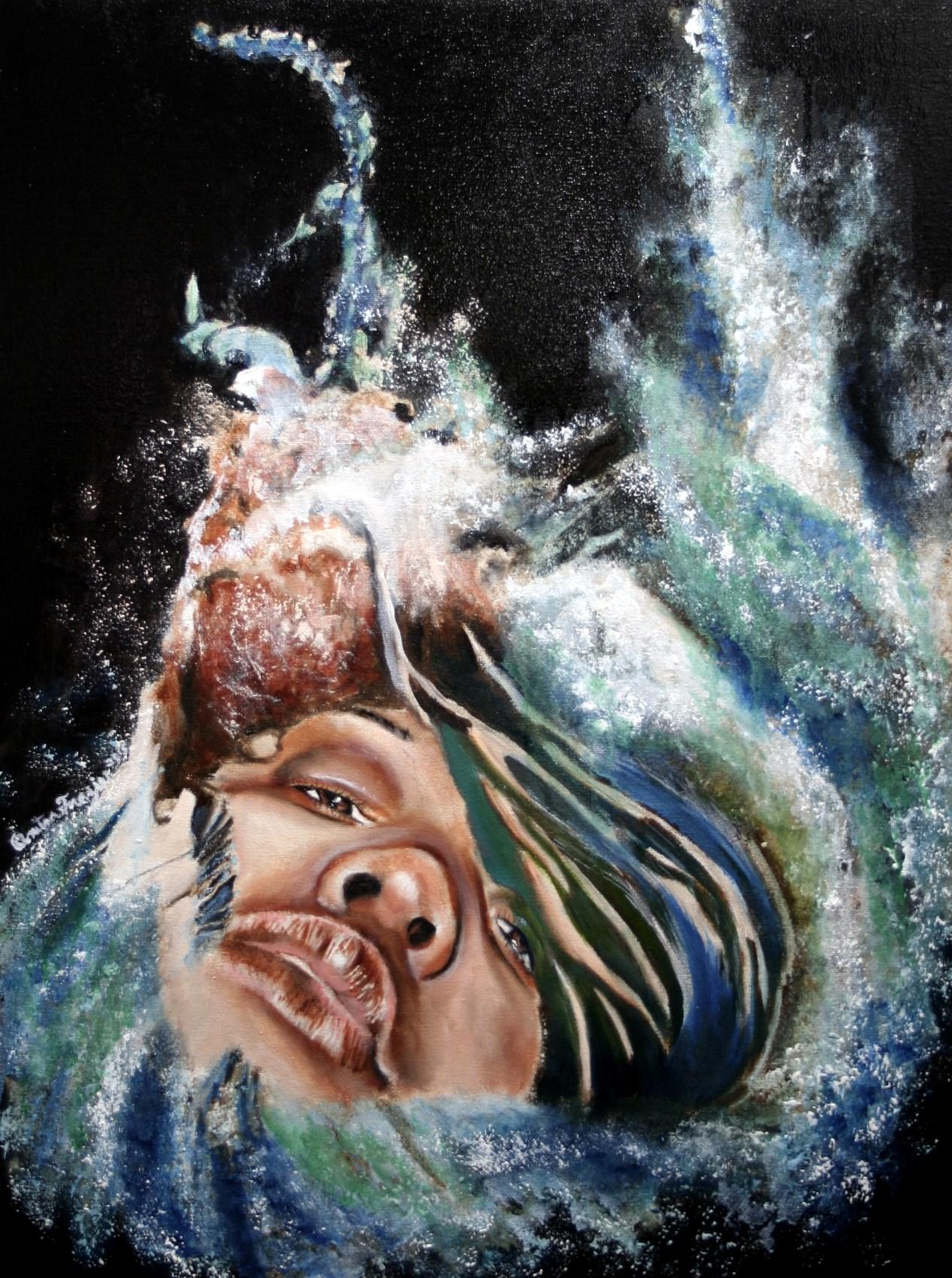
103
Sara Friedlander
Santa Cruz, California
www.lensculture.com/sara-friedlander
American Women: Birds of im/Migration—From Amsterdam to New Amsterdam
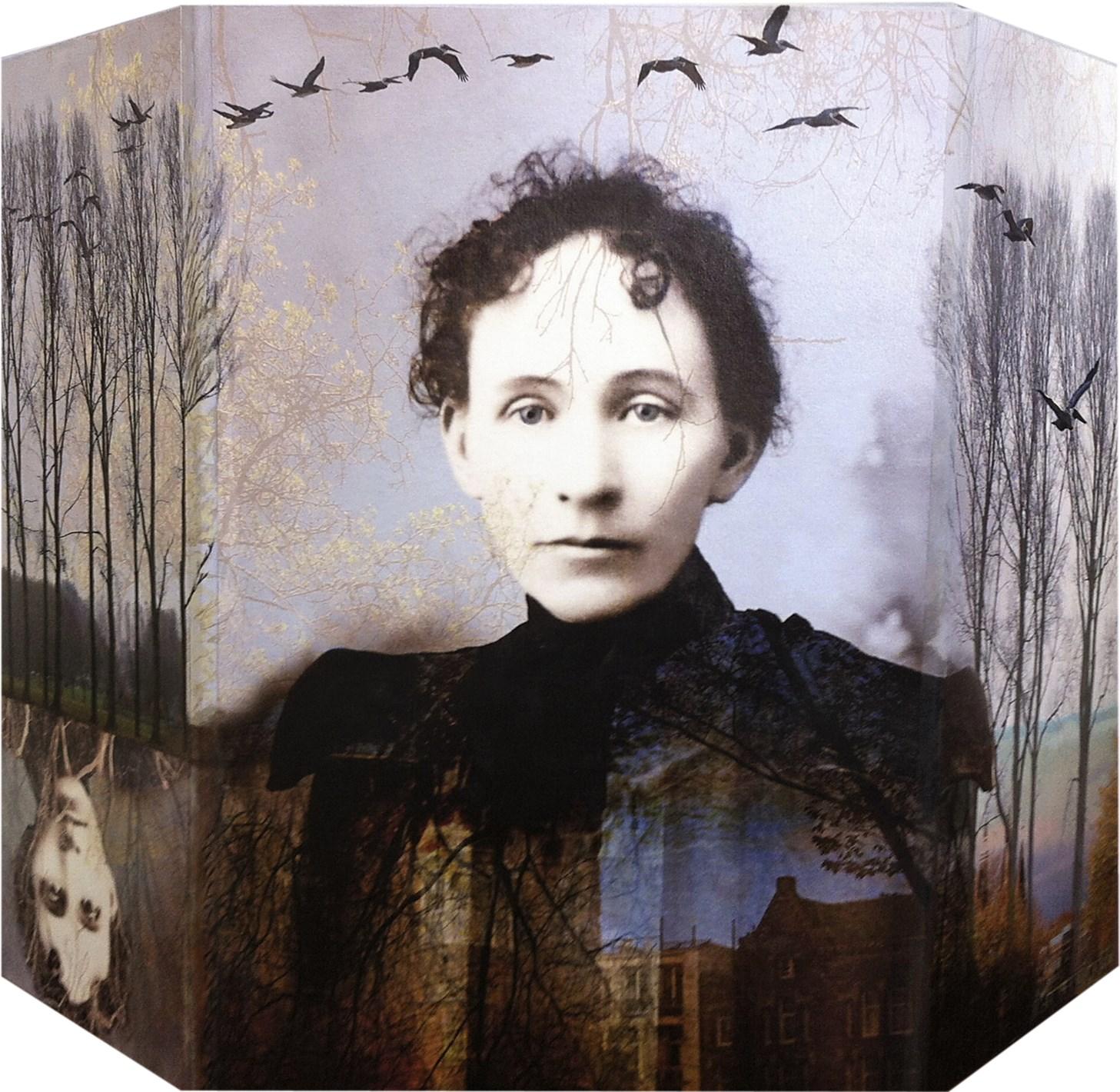
Mixed media: digital collage and paint on 3 sided wooden panel , 20 x 26 x 5.5 inches, 2015
At this critical time, when immigration is seen as a national and global threat throughout the world, these portraits can help us remember and reflect deeply on the reality that most Americans, most of us, are relatively recent descendants of immigrants ourselves. My vision was to create a series of 18 narratives on panels to honor these courageous women, who left their homelands and their families, often under great duress and traveled to America to start a new life. Most of them spoke no English; and holding steadfast to their hopes for a brighter future, faced daunting challenges in order to establish themselves in this new world. Their determination, their vision, is visible in their eyes. By collecting vintage portraits as well as images in the public domain (taken either in photographic studios or on the street during the first quarter of the 20th century) and using Photoshop to digitally combine them with my own photographs (landscapes, birds, trees, architecture), I pulled these 3-sided compositions together with paint.
104
Bala Cynwyd, Pennsylvania
www.SaraGalloMFA.com
Menstrual Cup Tiara, 3D printed nylon, 14 x 4 x 4 inches, 2015
Miss Menses is a series of wearable objects that embody an imagined pageant queen who advocates for women’s reproductive rights and the de-stigmatization of menstruation. My vision in creating Menstrual Cup Tiara is to celebrate women by effecting positive change in the way we view the transformation into womanhood. Instead of hiding or feeling shame from bleeding, women are empowered by this miracle from nature.

105
Sara Gallo
Caryl Gaubatz
Garden Ridge, Texas
www.carylgaubatz.com
Soledad, Linen, Dimensions Variable (art-to-wear), 2016
Soledad was inspired by the life and works of Adela Zamudio (1854-1928), a Bolivian writer, poet, educator and activist often credited as the founder of the feminist movement in Bolivia. She used the pseudonym “Soledad” (solitude) when publishing her poems to avoid prejudice and convey the isolation she felt. I based the jacket on a traditonal style but substituted linen for the usual velvet and tried to create a surface reminiscent of a stained and weathered page using deconstructed screen printing. Zamudio’s most widely known poem NACER HOMBRE( “To be Born a Man”), a satirical and vitriolic comparison of the lots of men and women in 19th century Bolivan society is embroidered with free-motion machine stitching.
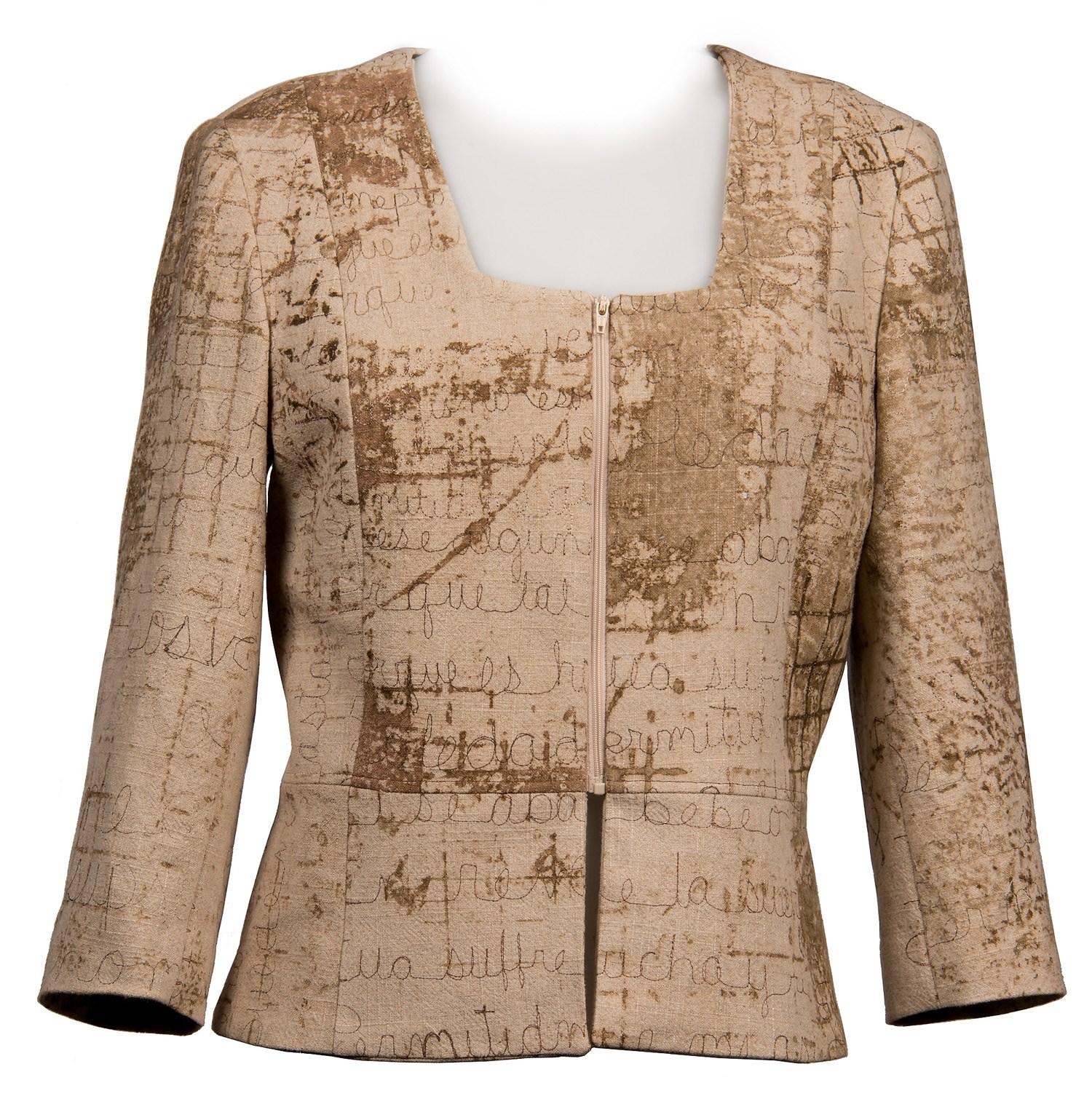
106
Linda Gleitz
Longmont,
Colorado
www.lindagleitzart.com
We Chose to Tell You That You Have no Choice in this Matter, Oil on canvas, 36 x 36 inches, 2015
I truly believe you can change the world through art. This piece is representational of my view of the world now where women have to fight for basic rights like the right to choose. My VISION is a world where we have won those battles and access to safe healthcare and privacy surrounding decisions such as abortion are every woman’s law protected rights.

107
Tricia Grame
Danville, California
www.tgrame.com
Women In Stone, series Vll, Hand made paper, acrylic, crushed stone, plaster on canvas, 58 x 45 inches, 2016
My art attempts to reveal a relationship of time, history, and the position of women; while celebrating the female image as an everlasting archetypal presence from ancient times. By giving all women a voice, I believe that sisterhood is the first step in eradicating oppression. Gender equality and the pursuit of emancipation creates balance, harmony, acceptance and equal access to education for women throughout the world. I create two and three dimensional art by incorporating mixed media materials aged by time, stone, metals, copper and pigment.
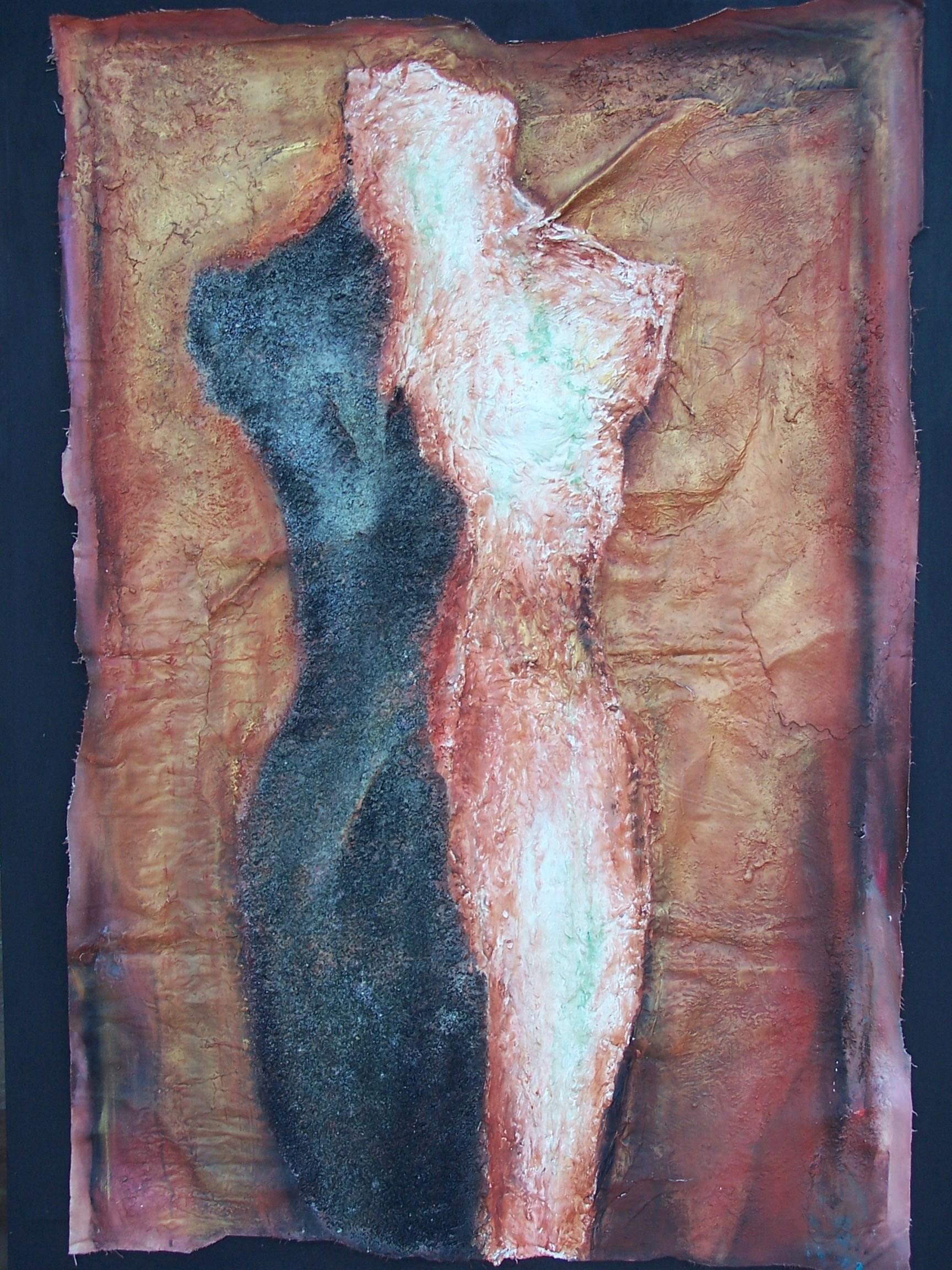
108
Georgie Humphries
Whitestone, New York
www.georgiehumphries.weebly.com
Numquam Obliviscar, Pencil on Bristol, 15.5 x 28.5 inches, 2016
Numquam Obliviscar depicts individual women from countries globally suffering from the “traditions” of their culture. Customs and traditions are prided on due to our strange need to cling to rituals, but mostly thrive on the backs of exploiting a certain group. In this case the group would be women and the figures are meant to be critical of our inability to evolve without the ill-treatment of the female gender.
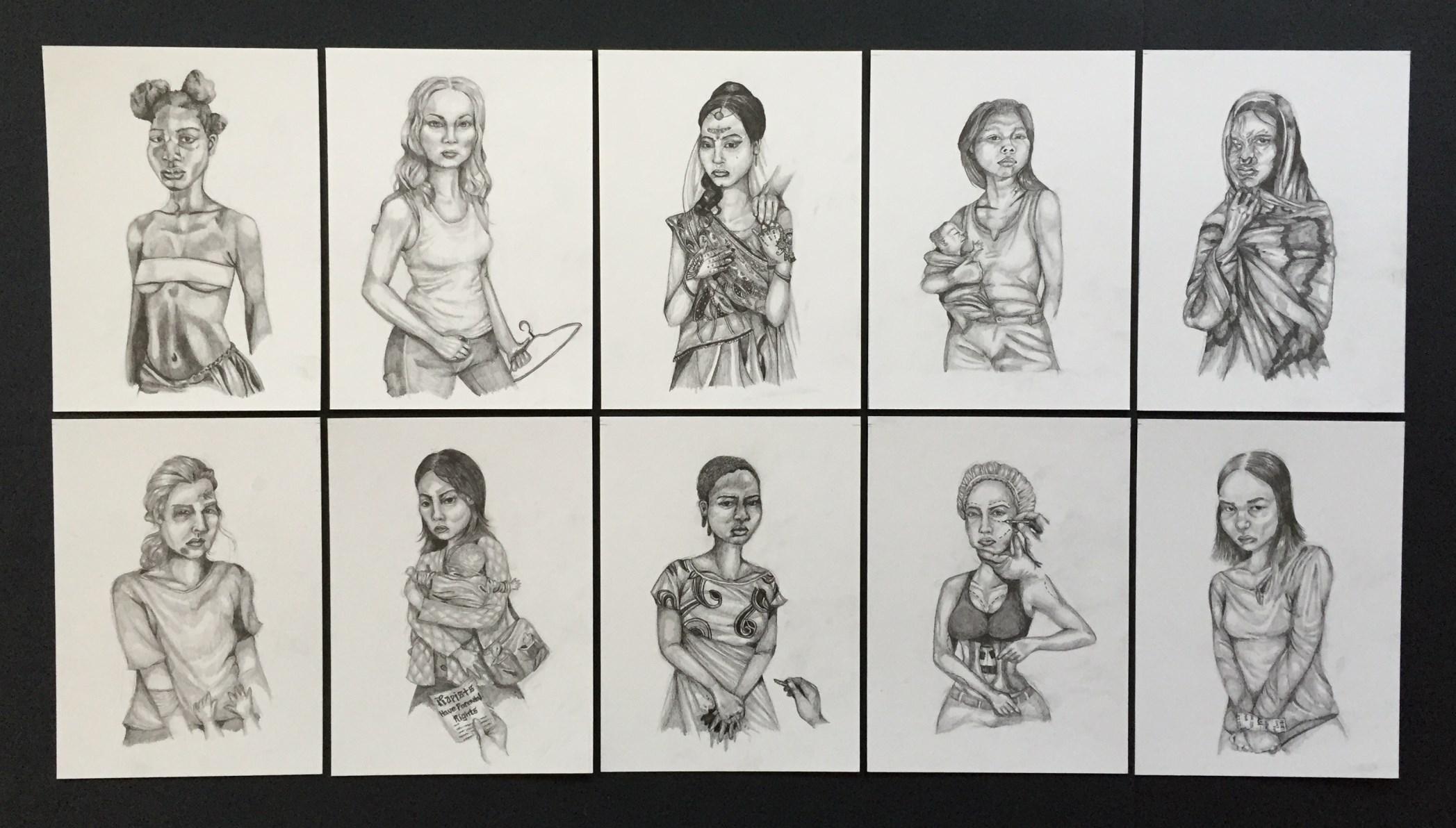
109
Uma Rani Iyli
Fremont, California
www.umaraniiyli.com
Garland Installation- 2, Thread, Q-tips, acrylic (mixed media), 108 x 36 inches, 2016
These are ‘tools’ used in making my paintings. This series connects me with memories of my childhood days when I made jasmine flower garlands with my mother. I see Q-tip material as transformative. Woven together, they also reference DNA strands. Biological references are a constant with my work hand in hand with ideas of identity, feminism and women’s work.

110
Olivia Jane
Las Vegas, Nevada
www.OHliviajane.com
Consent, Fishnet stockings, clear buttons, and polished tacks on drywall, 12 x 14 inches, 2016
My work exposes misogynistic fantasies embedded in our accepted behavioral norms. Society is inundated with damaging propaganda. Daily life, therefore, becomes a receptacle for adverse interactions. I parallel this interaction in my practice through the act of collecting symbolic remnants of the body and of the mind as represented through found materials. Through the combination of these objects, I scrutinize neglected social injustices and emphasize emergence from the debris of everyday life.
I use the fishnet style of stocking to encapsulate loose clear buttons, entrapping them a building on a form that mimics the texture of skin. The row of polished tacks puncture through the stockings, reflecting the viewer for a moment of connection. Consent highlights the sexuality of a woman with the seductive use of fishnets, bold stating that a sexual woman is in no way “asking for it”.
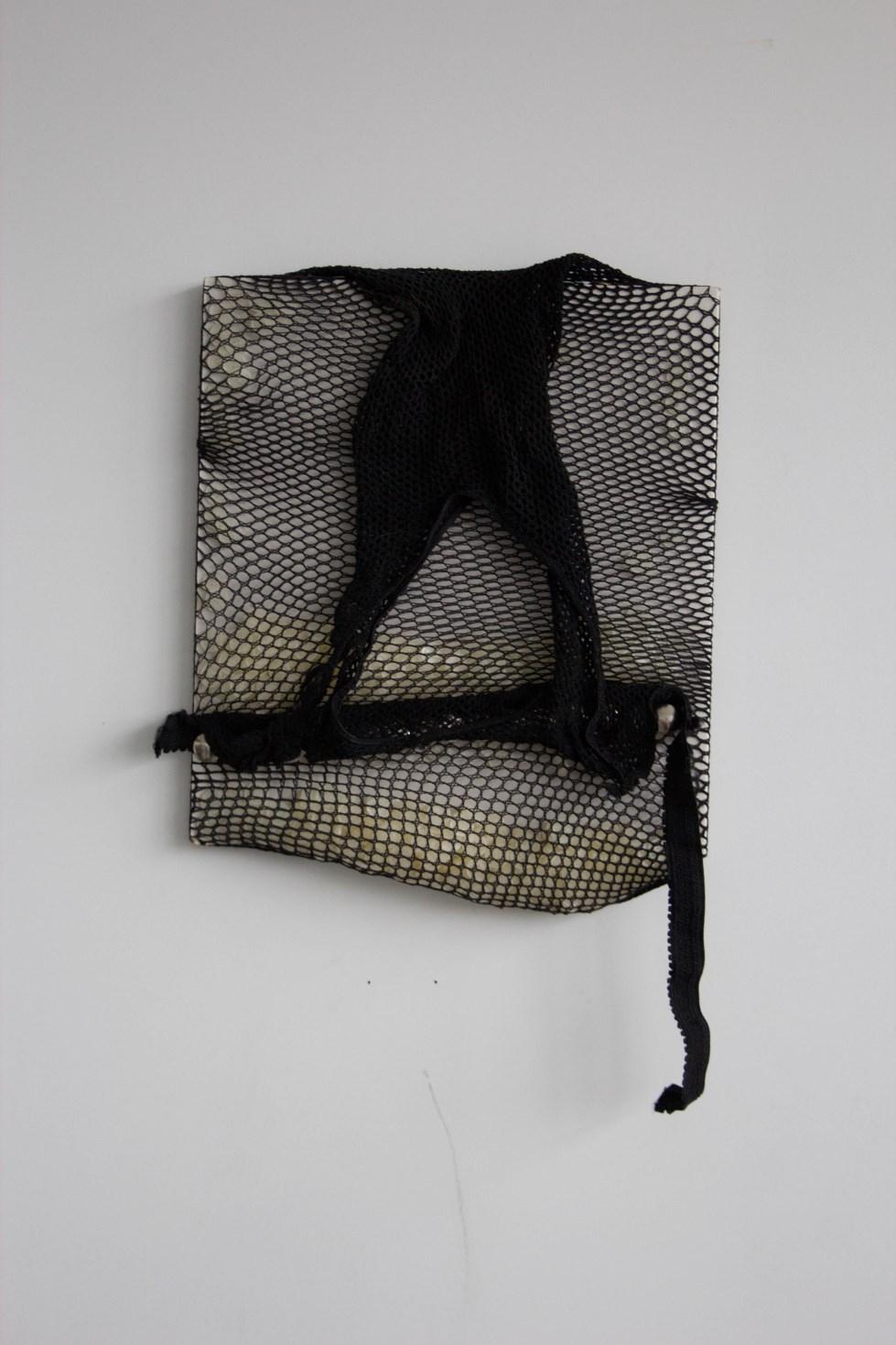
111
Kathryn Jill Johnson
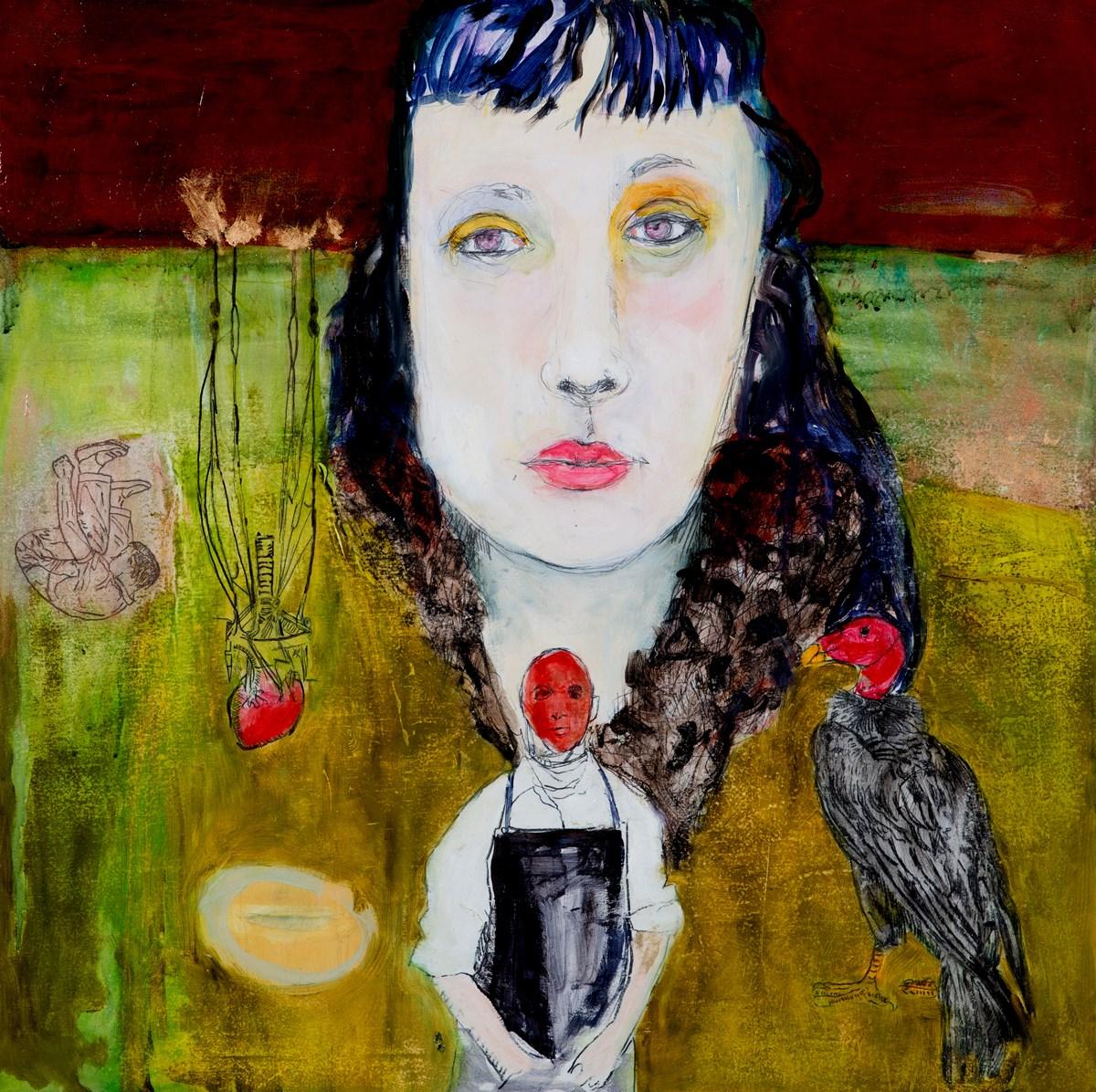
Huntsville, Alabama
www.kathrynjilljohnson.com
The Equivalence Principle, Mixed media on panel, 24 x 24 inches, 2016
I’ve been wondering about the agent that gives weight to experience. Is there a direct proportion of an event’s weight, the distance between it and the self that predicts its acuteness? Is the gravity of the situation, its awfulness, measured by the space between us and what happened? Remoteness in time, proximity to the body, and the possibility of intervention— this is what I am parsing out.
112
Thuy Linh Kang
Orinda, California
www.linhkang.com
Taking Flight, Oils, acrylics, and resin, 36 x 48 inches, 2015
In this time of global conflict, one must be relentless to be the voice of the unheard victims. This work is part of a body of work that honors victims of past wars. A child, whose life and innocence is robbed, set against a background of oils and washes. Pools of color cleanse and purify the tragedies of war. The wings carry the child to freedom.
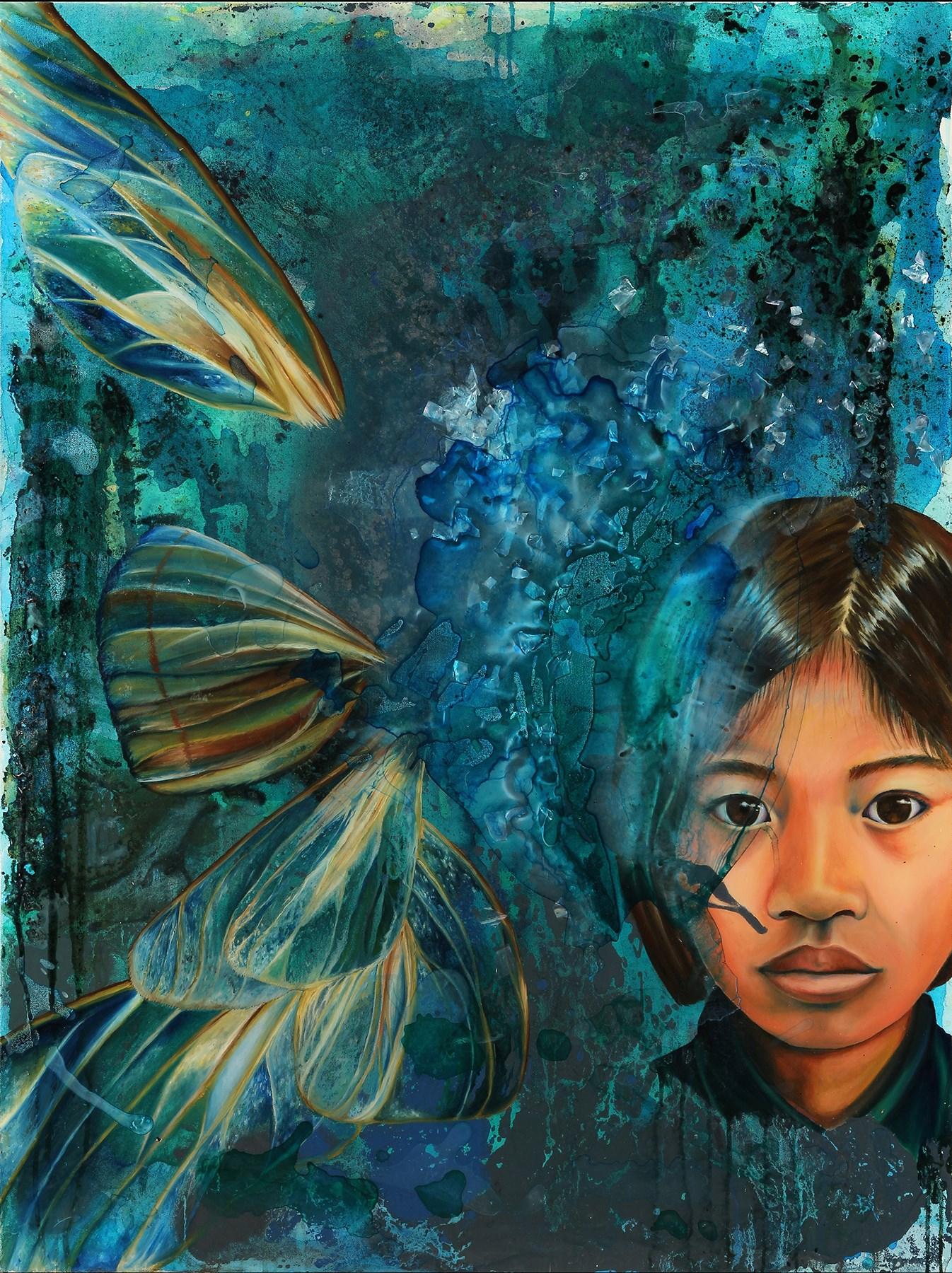
113
Long Island City, New York
www.kristinkempa.com
Polaroid, Butterflies, and Blood, Digital images printed, 10 x 10 inches, 2016
Over the past few years, Kristin Kempa has been documenting her life as she lives with endometriosis: a painful and often debilitating condition in which tissue similar to the lining of the uterus, grows outside of the uterus, affecting the reproductive system, as well as invading other organs. Kempa hopes to start a dialogue concerning endometriosis as a feminist issue, both in terms of treatment options and general awareness in mainstream society.
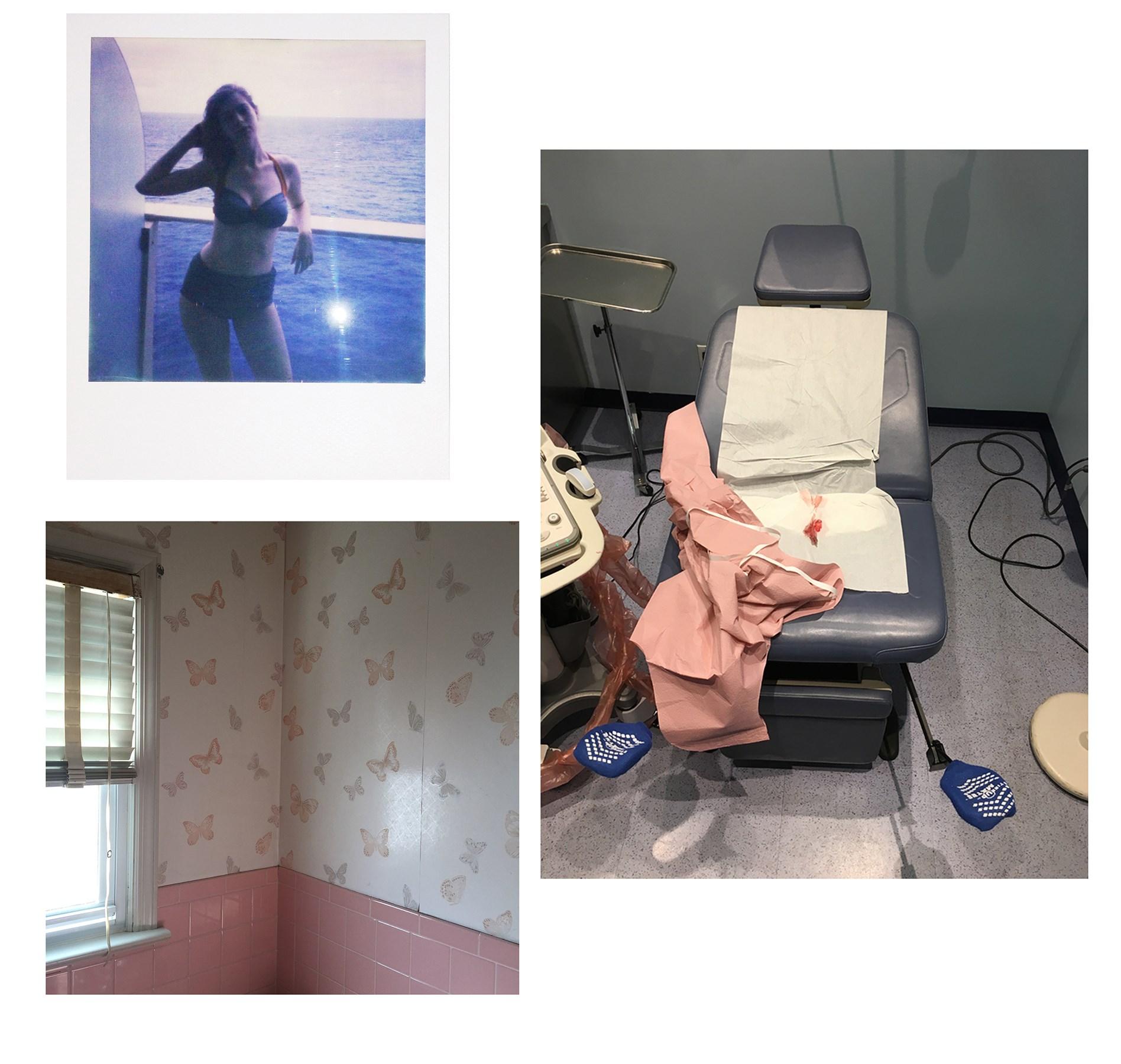
114
Kristin Kempa
Sameh Khalatbari
San Jose, California
www.samehkhalatbari.com
Human, Endless Dream, Acrylic on canvas, 36 x 48 inches, 2015
Sameh Khalatbari is San Jose based Iranian artist whom uses symbolic Persian art to express her views. Human, Endless Dream signifies the fact that despite all the efforts made to cloud women’s visions they still generate life and prosperity. This work of art essentially and specifically addresses the rotten constraining superstitious ideas which are impose on women of the 21 century.

115
J.L. King
San Francisco, California
www.jlkingart.com
Some Form Of Apophenia, Oil on canvas, 30 x 40 inches, 2015
Apophenia is the tendency to perceive a connection with unrelated objects or ideas. My need in finding connection is insatiable. Though, as I grow older, I see that need for connection increasingly turning inward. Towards connecting with myself and finding meaning and value in all that I do, and a comfort with who I am.

116
Epiphany Knedler
Vermillion, South Dakota
www.epiphany-knedler.squarespace.com
Choice is Hard, Digital print, 11 x 17 inches, 2016
As a woman living in the Midwest, one of the most pertinent issues I deal with is reproductive rights. In Choice is Hard, I wanted to show the difficulty of having your choices taken away in contemporary America. I chose to display this in a satirical, vintage advertisement while commenting on the different economic situations. These perspectives are imperative to address the needs of women and how securing these rights can affect their lives.

117
Susan Kraft
Redwood City, California
www.kraftart.com
Hidden Life Wearing Heels, Oil on canvas, 48 x 32 inches, 0
Examining implicit gender identification, this body of work is my personal search for answers to questions from my past; growing up in newly liberated times, and no understanding why these rights my rights, were vilified and pushed down away from me. Working on these pieces gave me a way to discuss it before I could talk about it and clear away rhetoric and search for truth in women’s history, my history.

118
Biljana Kroll
Ashville, North Carolina
www.biljanakroll.myportfolio.com
The Goddess, Digital, 20 x 30 inches, 2016
I’ve been working on a digital collage series called Love/Lust which started as a research through the online art archives of the Dutch national museum, Rijksmuseum. The Goddess is part of that series which focuses on portrayal of women in fine art (created mostly by men). Most of it focuses on the outward beauty of women featuring them as goddesses or other mythological beings. While I admire fine art I often question its motifs as I use the old and give it a new voice in my pieces which focus on capturing the inner workings of a woman’s mind.
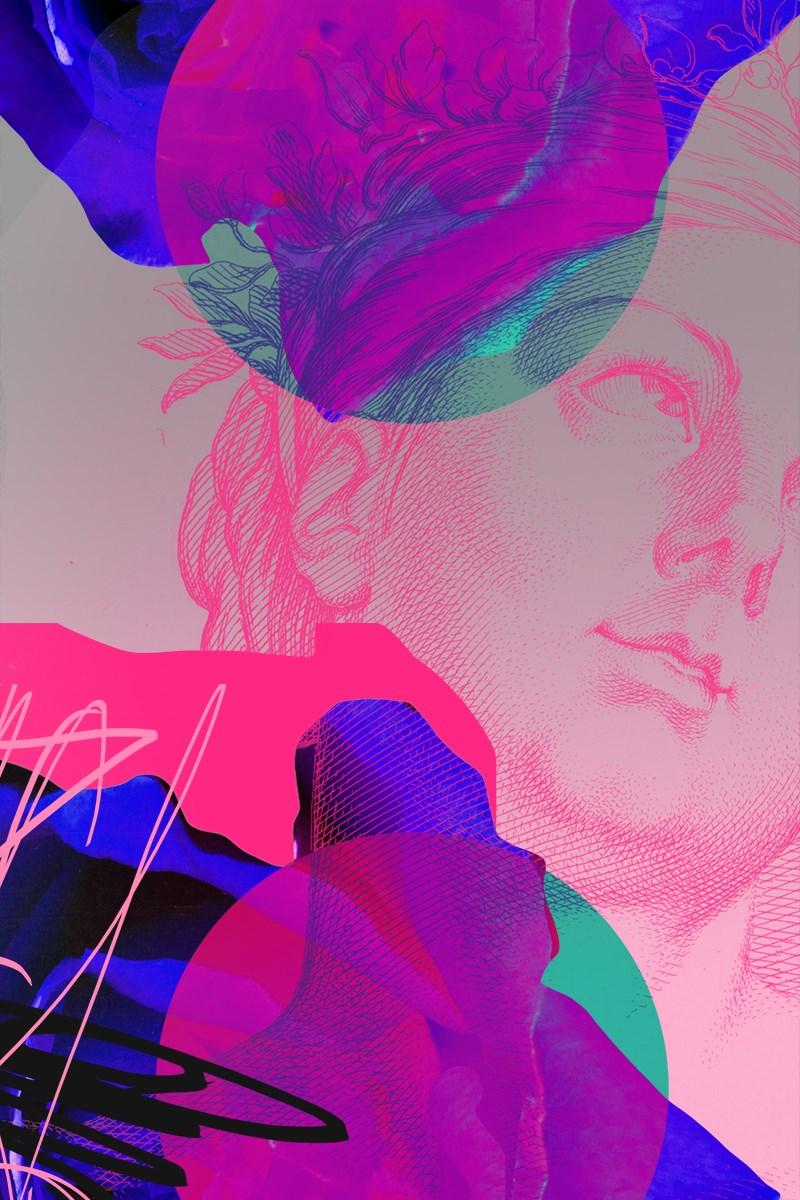
119
Krista Machovina
Los Angeles, California
www.Kristamachovina.com
Torschlusspanik, Oil paint, vintage paper, watercolor paper, 11 x 14.5 inches, 2016
Torschlusspanik, “gate-shut panik”, roughly translates to fear that time is running out. This work considers the perceived pressure of time on a woman’s decisions that execute the vision of her life, no matter what period in history, no matter what the choice or path.
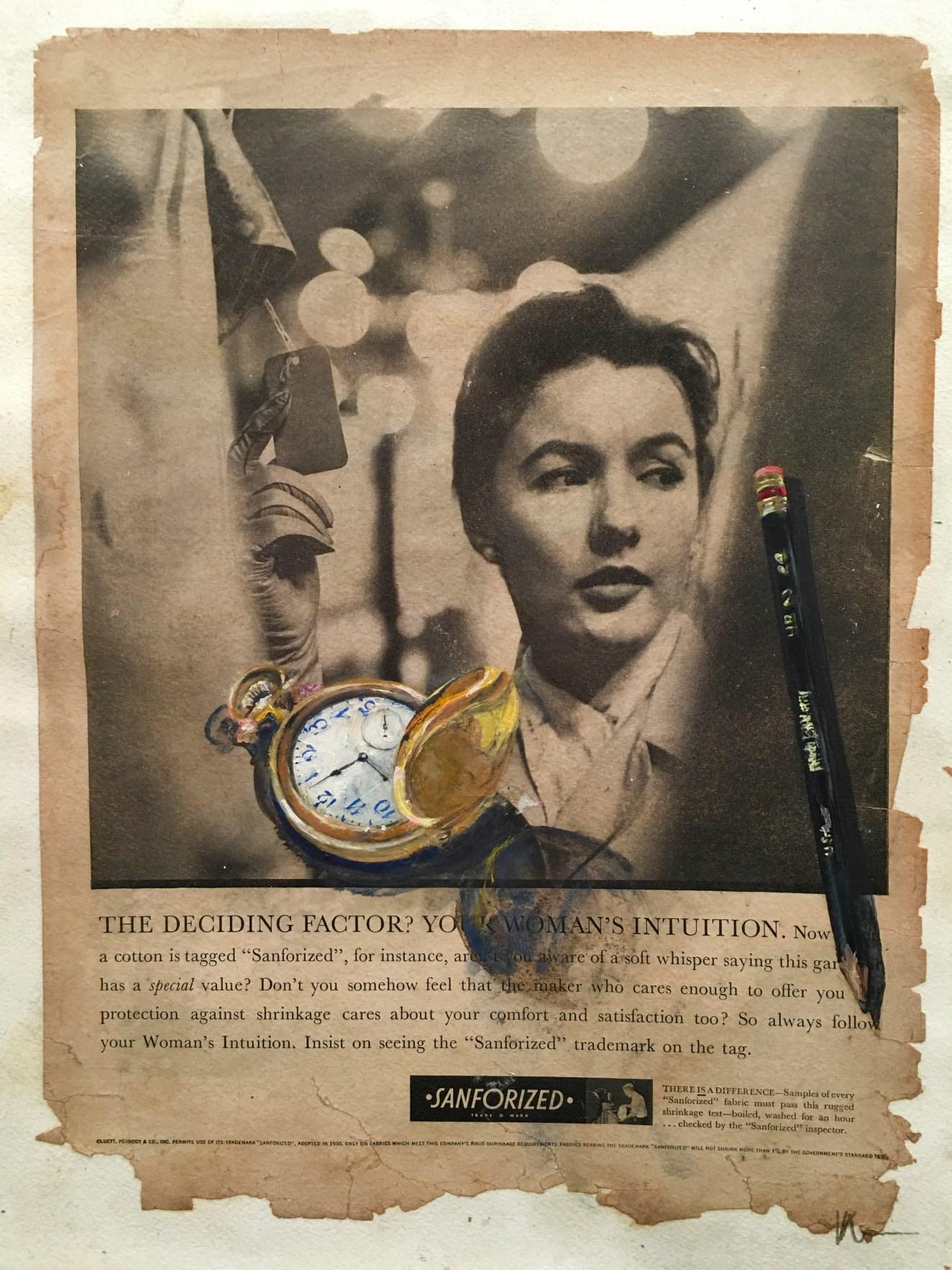
120
Stela
Mandel
Greenbrea, California
www.stelamandelart.com
Women’s Health for Dummies, Digital image , 8 x 10 inches, 2014
We have been hearing some creative statements about women’s health by misinformed or cynical politicians. Where do these people get their ideas? Women’s Health for Dummies reveals the building blocks of the science used by these persuasive decision makers. The cover art for this book includes a conceptual medical illustration of “legitimate rape”, just one example of the absurdity and contempt in statements meant to mislead voters. Update: I’m thinking about renaming this graphic to “I love the poorly educated”.
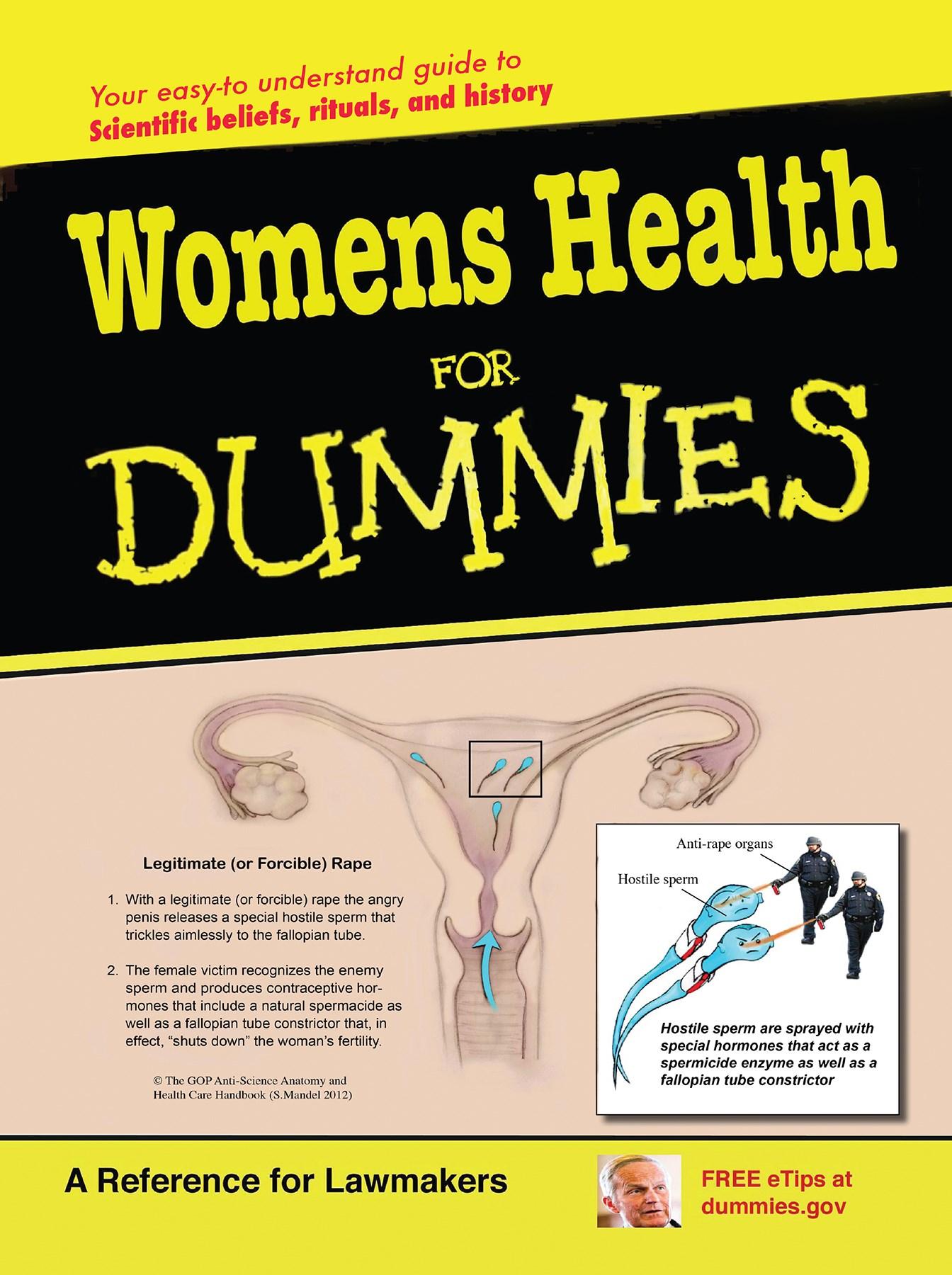
121
Juliet Mevi
Oakland, California
www.facebook.com/mevi-art
Post-War and Pre-Choice, Acrylic on canvas, 20 x 28 inches, 2015
A turning point in American history and American “Vision” was the birth of the “Baby Boomers”. Victory and prosperity make America a superpower but it is the vision of its children that bring about the volcanic changes that allow for social justice and equality that change the fiber of the American soul.

122
Jennifer Mondfrans
San Francisco, California
www.jennifermondfrans.com
Agnes Pockels, Acrylic on canvas, 18 x 24 inches, 2015
Agnes Pockels never went to college because she had to take care of her sick parents. One of her daily duties inspired a new realm of science. Agnes looked into dirty dishwater and saw how to create her own experiments studying surface tension. Her work was fundamental in establishing the modern discipline known as surface science.

123
Shabnam Mottaghi
Columbus, Ohio
www.shabnammottaghi.com
Life, Acrylic on canvas, 51.2 x 39.4, 2010
Our life includes various contradictions, like Night and Day, Black and White, Good and Evil… But surprisingly, when these contradictions get together, they make beautiful concepts and create ideas, thoughts, creativity and life. There are always differences, the question is: How do we deal with them?

124
Jelisa Peterson
N Salt Lake, Utah
www.jelisapeterson.com
Stand Tall, Paper, 20 x 24 inches, 2013
Let’s help girls all over the world to STAND TALL by uniting as a global community and demanding education for each and every girl. This is VISION.

125
Sara Petitt
New York, New York
www.CarterBurdenGallery.org
Forced Late Stage Abortion China, Collage on acid free paper, 13 x 19 inches, 2015
As a woman I am concerned with global issues that take freedom of choice away from women. For many years I was a textile designer and fabrics from different cultures fascinate me with their rich variations. I try to incorporate an important message surrounded by the images of beautiful fabric.
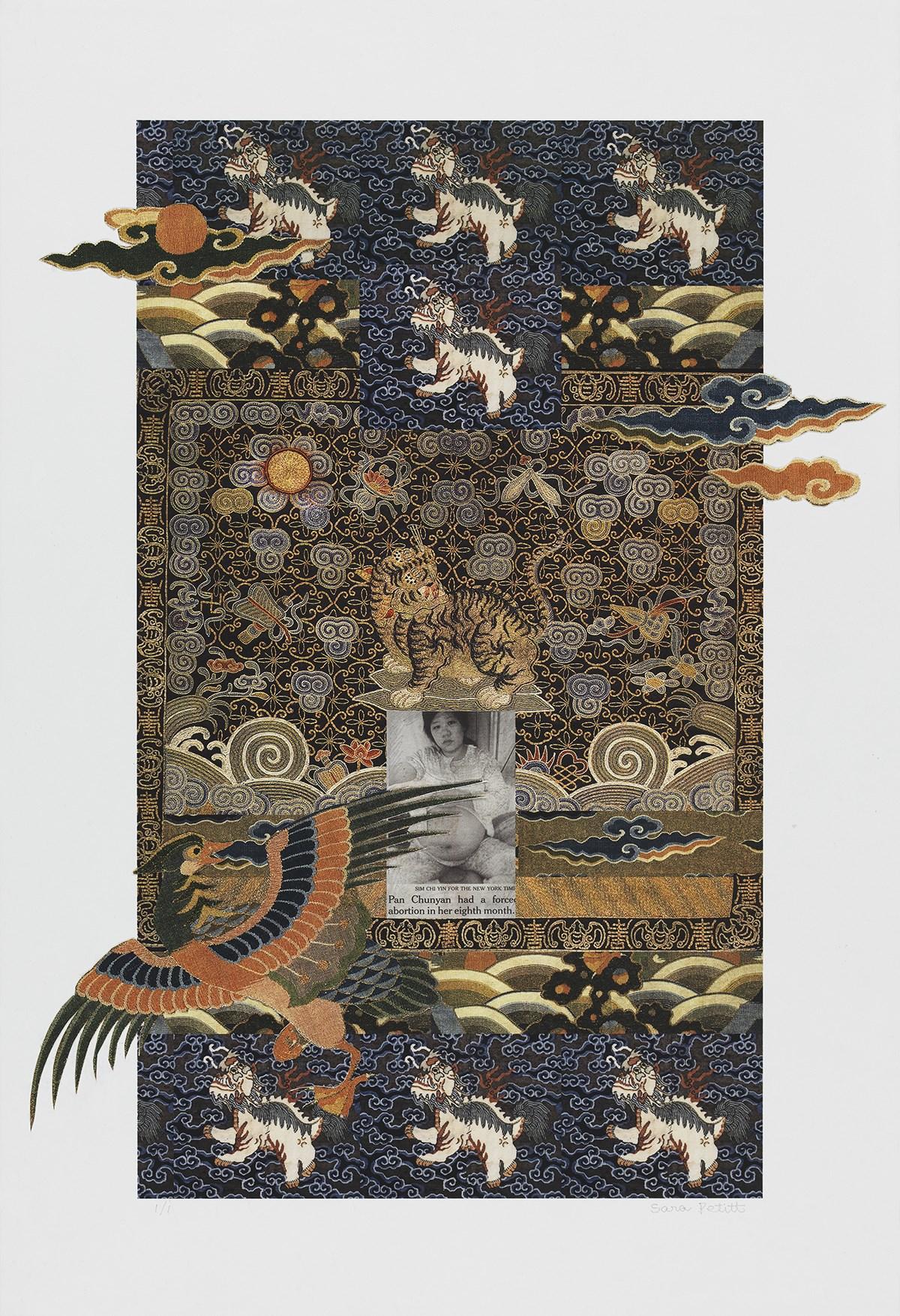
126
North Kingstown, Rhode Island
www.lorenapugh.com
Luna, Oil on aluminum, 24 x 24 inches, 2015
My painting Luna is about unity of power. Forces will work for you if you work for them. It’s about the power of woman and the power of the mind.
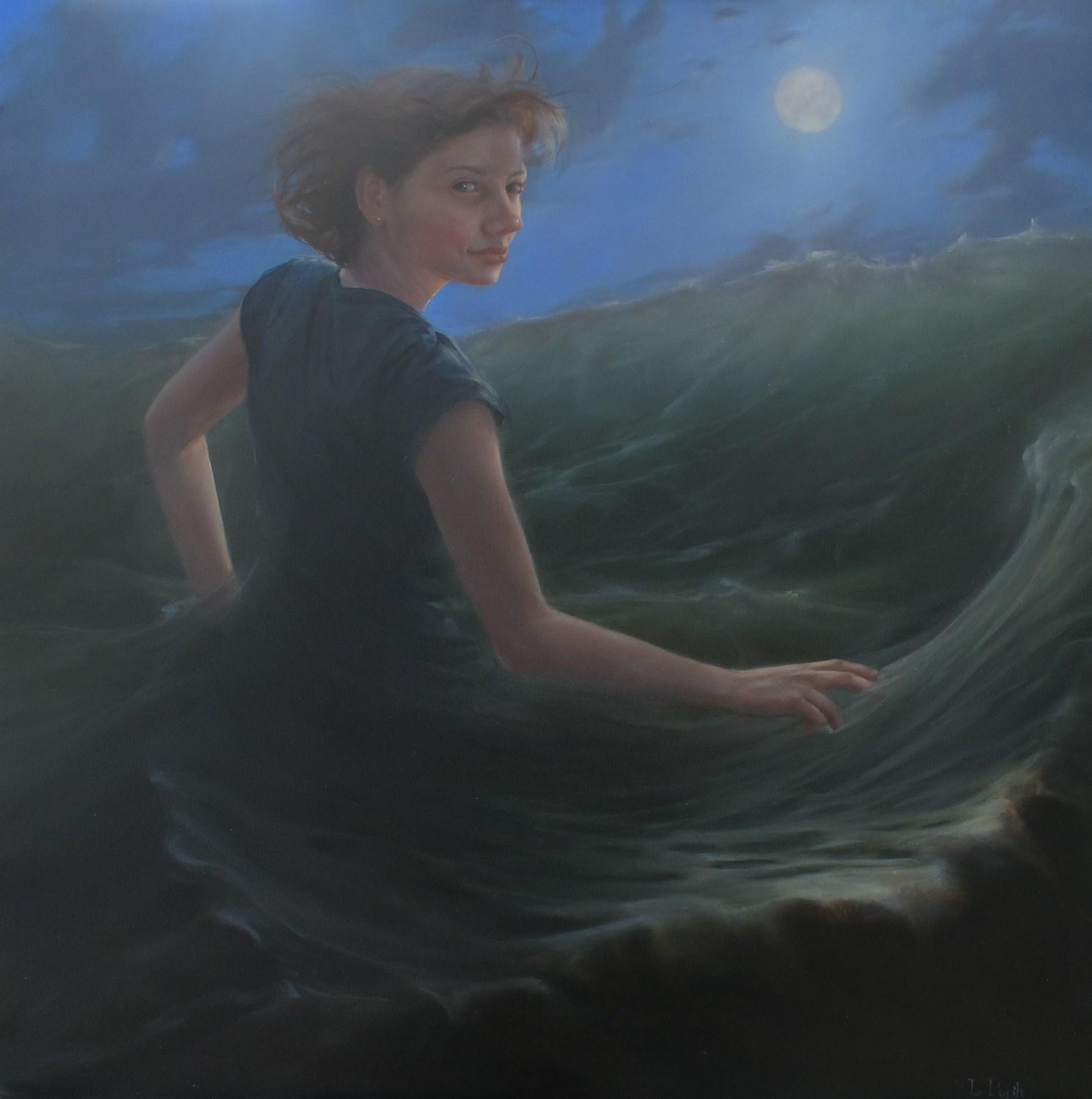
127
Lorena Pugh
Trix Rosen
Jersey City, New Jersey
www.trixrosen.com
SHADOWY WORLD OF DREAMS, Fine art exhibition inkjet paper with archival pigmented ink, 16 x 20 inches, 2016
How does ageism affect gay men as they strive to maintain their visibility in a youth-oriented culture? For Shadowy World of Dreams, (2016) gender performance artist, Fred Koenig, portrays an older, still handsome and beautiful figure, who may be looking back at his glittering past or towards the light of a hopefully dazzling future.

128
Gerri Russell Los Gatos, California
Where Has She Gone-II, Mixed media, image, paper, raw pigment, acrylic, 16 x 20 inches, 2015
My artwork is deeply personal and at its core, reflects my own interpersonal exploration. This painting is one in a series of twelve pieces that were created over a year of personal work about identity and life changes that impact identity and who we grow up to become. The work incorporates a photo of myself at five years old. For me, it captures innocence, trust and love.

129
Pallavi Sharma
San Ramon, California
www.pallavisharma.com
Soliloquy, Projector, water tank, handmade lamps, saree, and bangles, 60 x 48 inches floor video installation, 2013
Soliloquy is a series of participatory work about ‘self-talking’ and ‘deep listening’ in relation to class, gender and ethnicity. Here through metaphors and symbolization, the film attempts to touch upon the interrelationship between south Asian ritual practices and patriarchy. To bring out the irony of victim’s life, the film builds upon the verse composed by medieval Indian saint poet Kabir “Jal bich meen pyaasi” which literally means “fish remains thirsty in the water”.
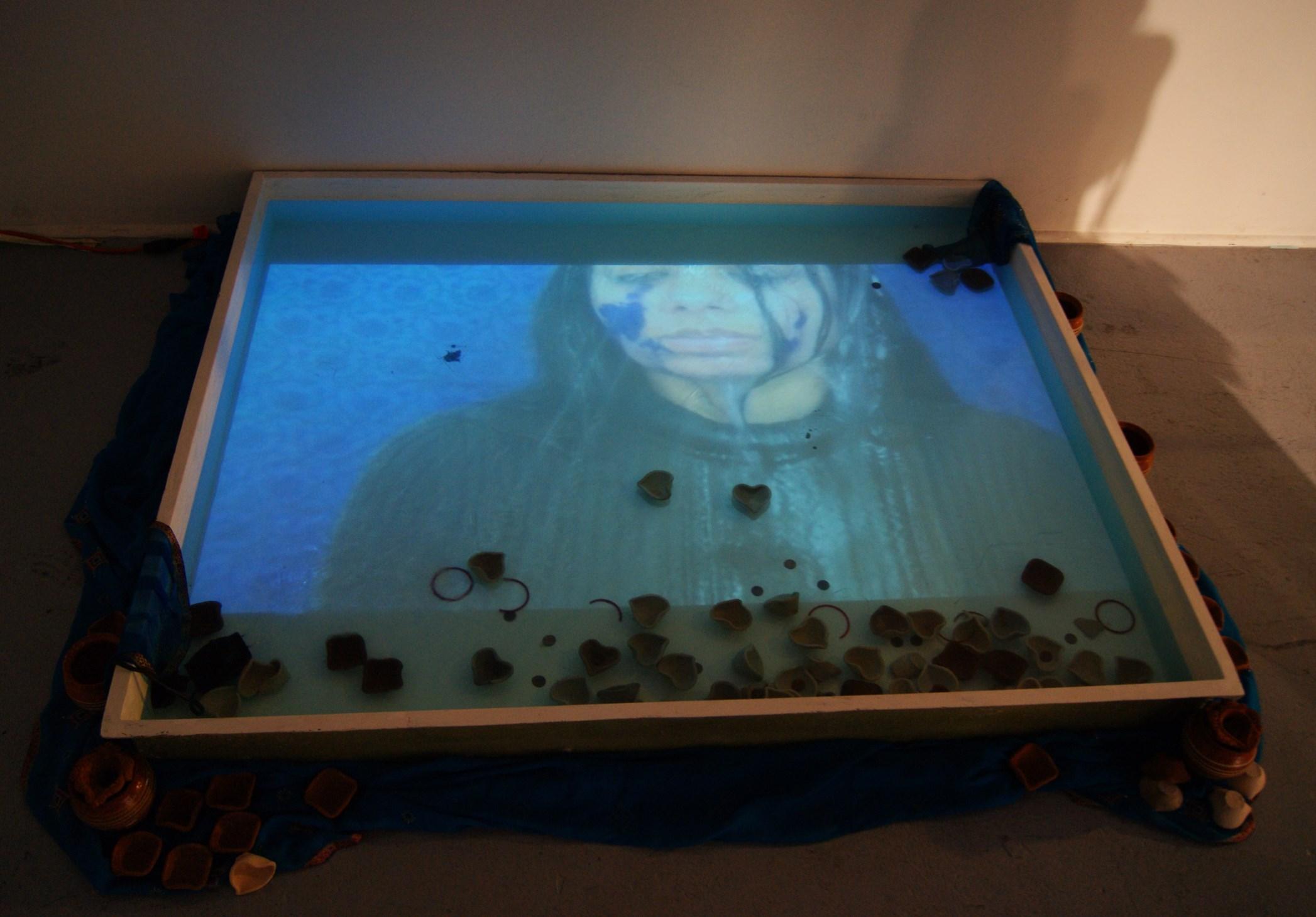
130
Marlene Siff
West Port, Connecticut
www.marlenesiff.com
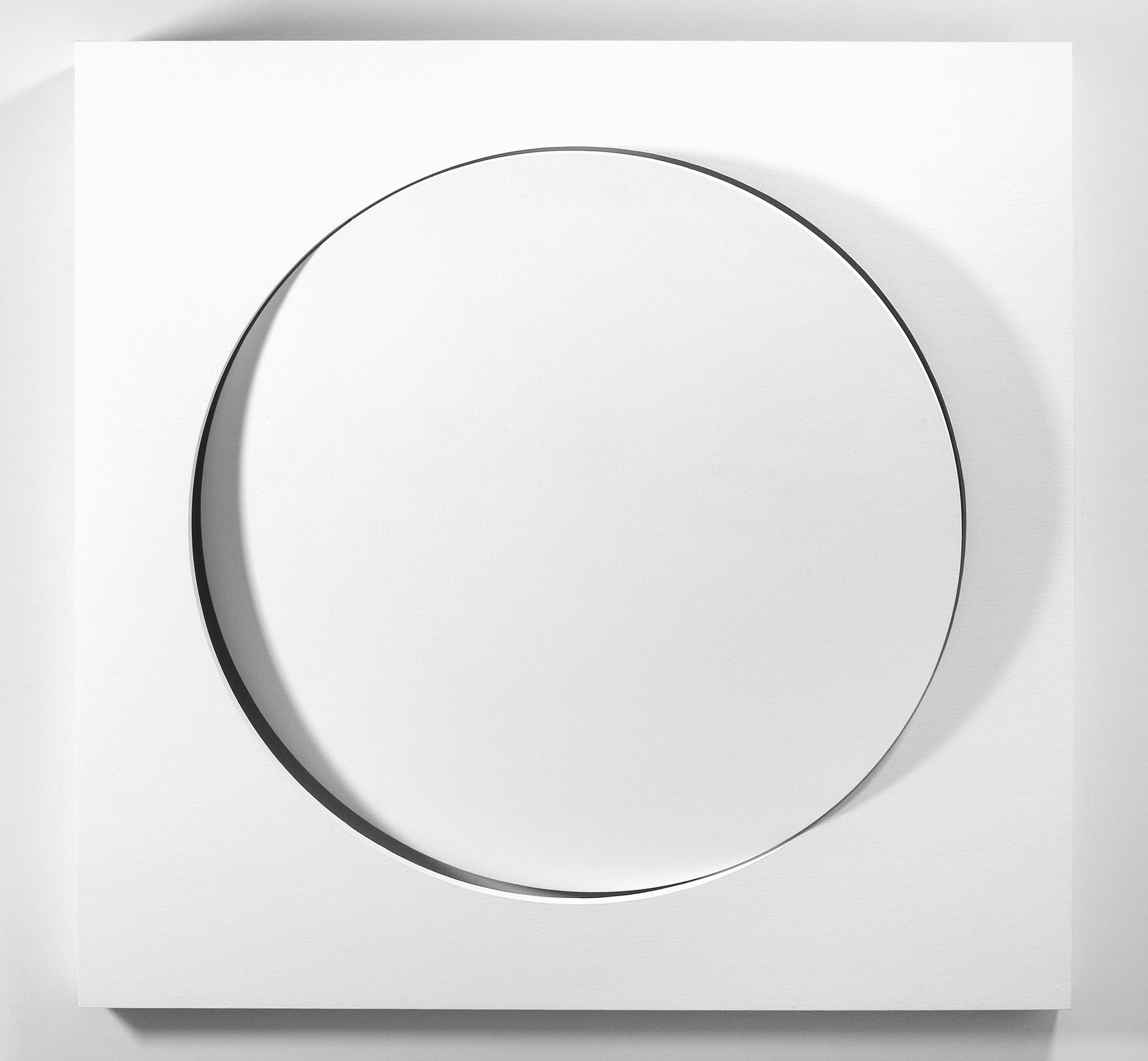
Shifting Balance, Acrylic on linen, 60.25 x 60.25 x 10.75 inches, 2011
Shifting Balance belongs to my body of work entitled Elements of Peace. Color has been my muse forever but for this series some of the works are painted in shades of white. White represents an environment associated with peace and rest. It is soft, quiet, spiritual, unadorned, and full of infinite possibilities. Conceptually the act of keeping a painting white became an exercise in self-restraint and sacrifice, indicative of my need to somehow respond to war, and symbolically give something of myself.
131
Grand Haven, Michigan
Icy Path to the Asylum, Cut paper, 17 x 8 inches, 2016
This cut paper piece reflects my opinion about the state of mental health care in America. A slippery slope indeed!

132
Sean Sterzer
Randallstown, Maryland
Two-Lipped Silence: Trophy, Paper, 10 x 20 inches, 2015
Trophy is from the Two-Lipped Series. Each piece specifically addressed possible roles and perceptions of women in society while giving recognition to many of the women by name who have lost their lives at the hands of policing systems. Too often, black women seem to be invisible and omitted from the discussions about violence, policing, and social justice. As we speak their names, we must remember all women are more than a vessel, trophy or an accessory.
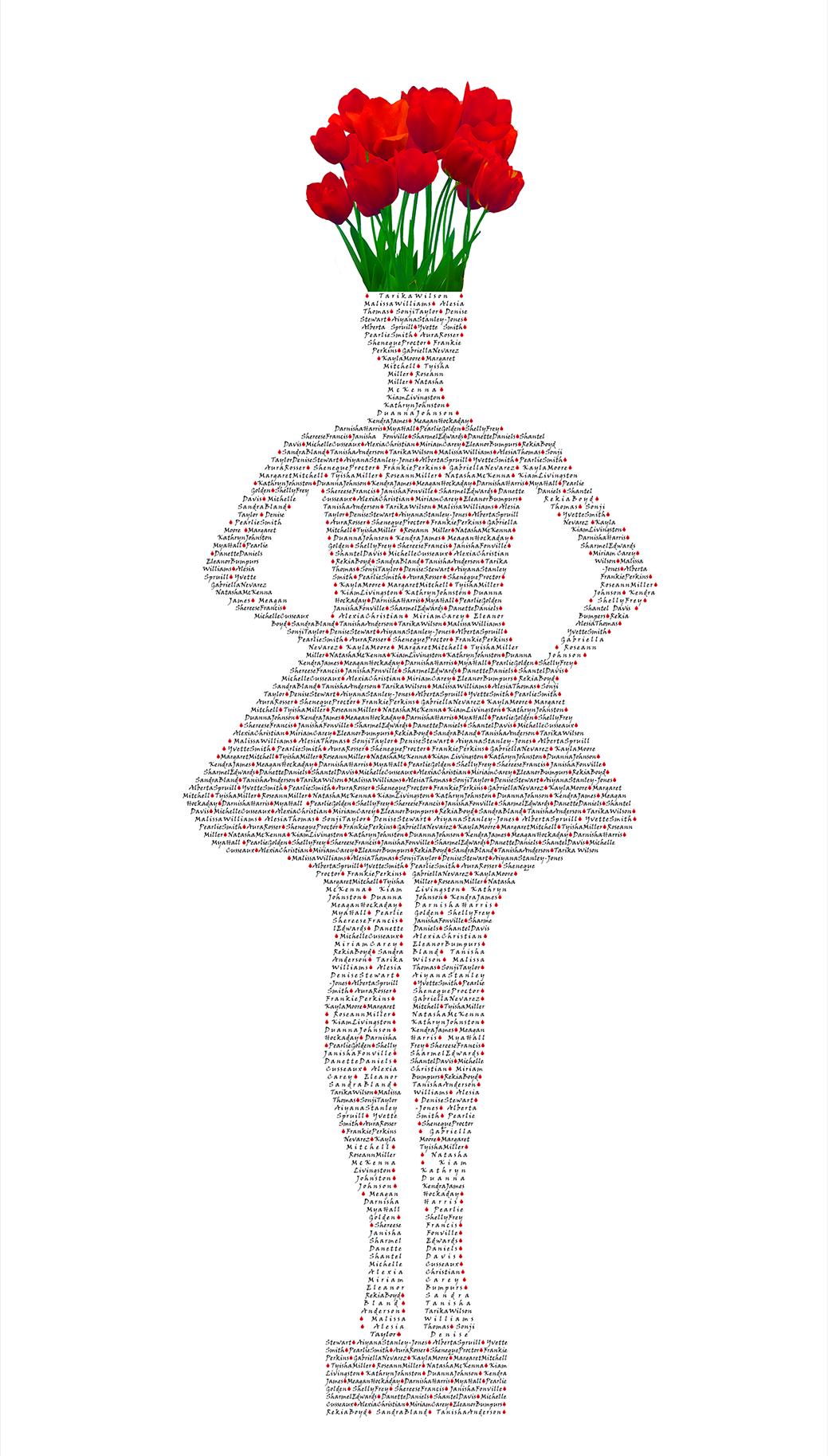
133
Elka Stevens
Kim Tepe
Bellevue,
Washington
www.kimtepe.com
Ice Bleeds, Hand dyed silk fabrics, organza fabric, 16 x 20 inches, 2015
I was inspired by a picture in National Geographic of the Taylor Glacier in Antarctica. While the red water seeping from the glacier is due to microbes in an underground lakes, Global warming is real and as the polar ice caps melt, the earth is left exposed and wounded. What are we leaving for our grandchildren and their children?

134
Bozeman, Montana
www.dianatremaine.com
Patriarchal Punch, Oil on canvas, 40 x 40 inches, 2016
Patriarchal Punch is quite simply about rejecting patriarchal fear in ALL it’s facets: fear of the patriarchy, fear fueled by the patriarchy, as well as fear harbored in the collective psyche of the patriarchy fear of women, of creativity, of animals, of Mother Nature, etc. The image suggests a future where young women embrace their full power and potential with conviction and authority.

135
Diana Tremaine
Somerville, Massachusetts
www.jenniferweigelart.com
Plainskeeping, Digital photography on metal, 7 x 5 inches, 2014
I created Performances for the Kansas Sky as an acknowledgement of the immensity of nature and celebration of the vastness of the landscape. These works were a partnership with Laurel Luckey, my best friend since 3rd grade, who shot the photographs. Plainskeeping includes the Keeper of the Plains by Blackbear Bosin and myself in mimicry as homage; we all must take notice and be aware of our impact on our surroundings to raise consciousness of both environmental and social realities.

136
Laurel Luckey and Jennifer Weigel


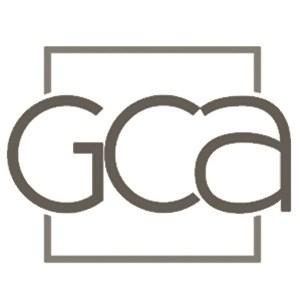


 Karen Gutfreund and Sherri Cornett
Karen Gutfreund and Sherri Cornett



